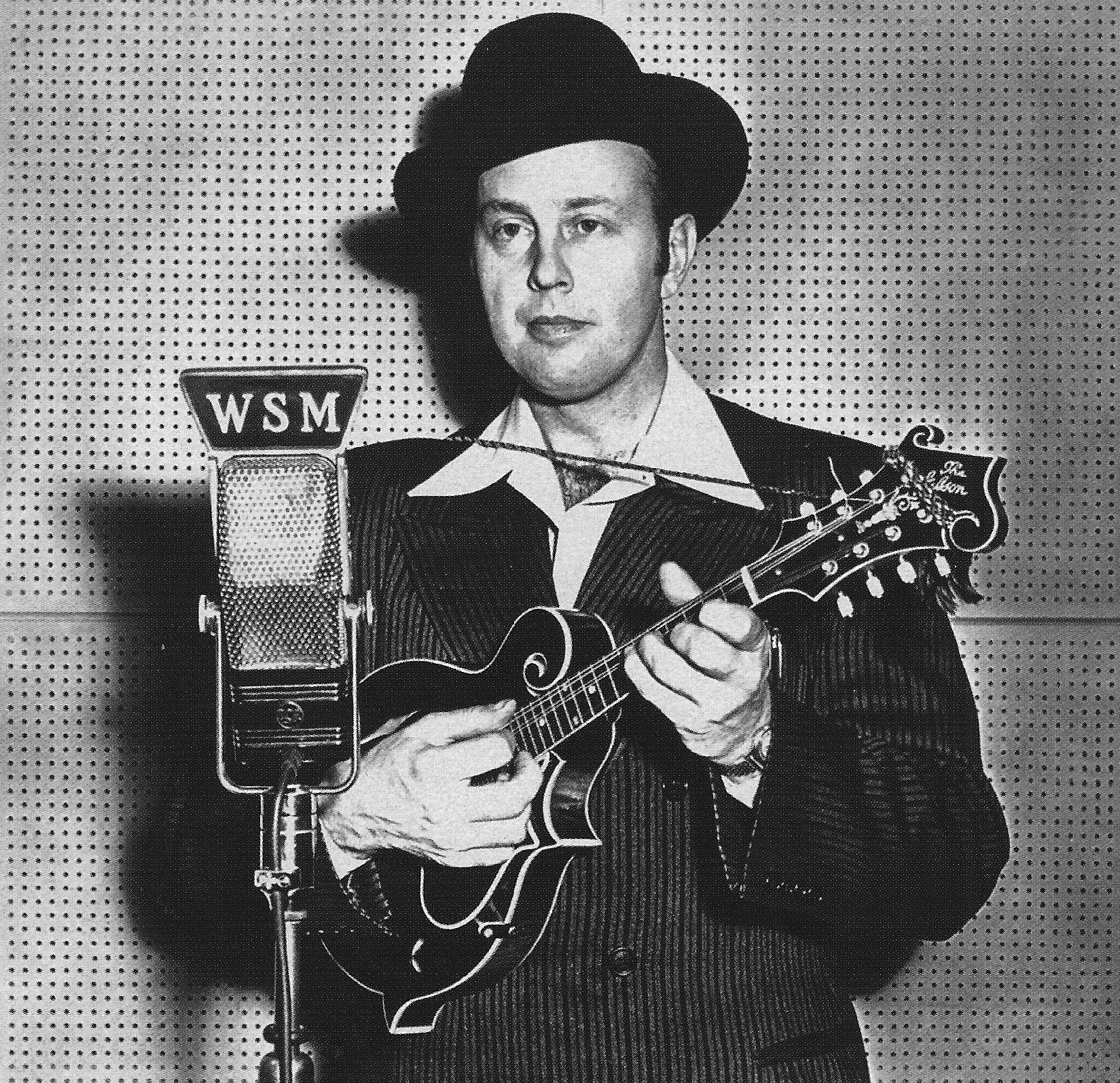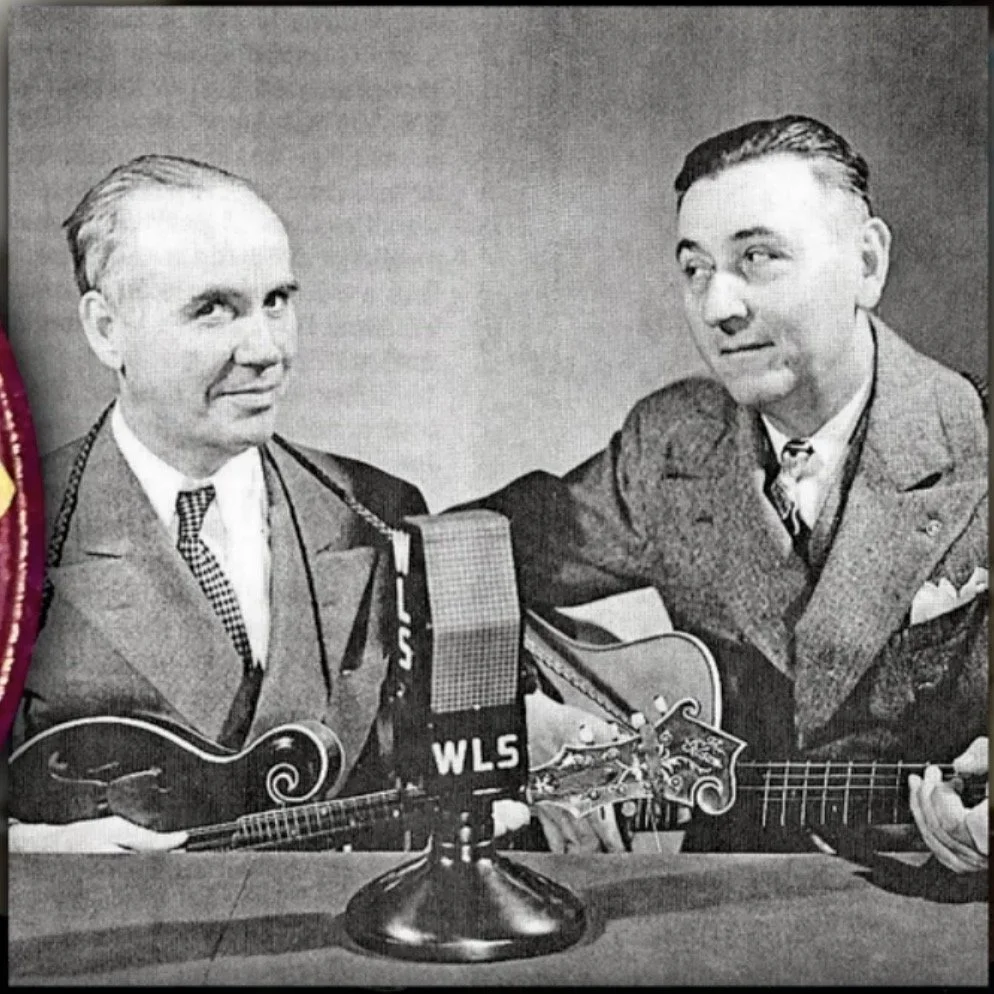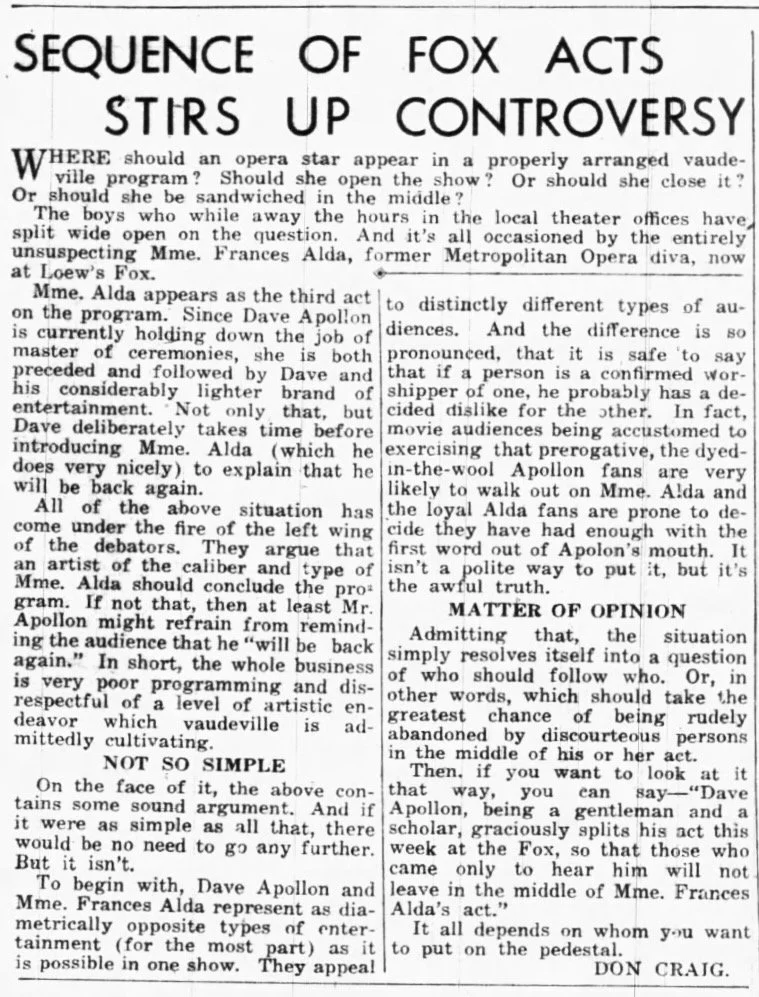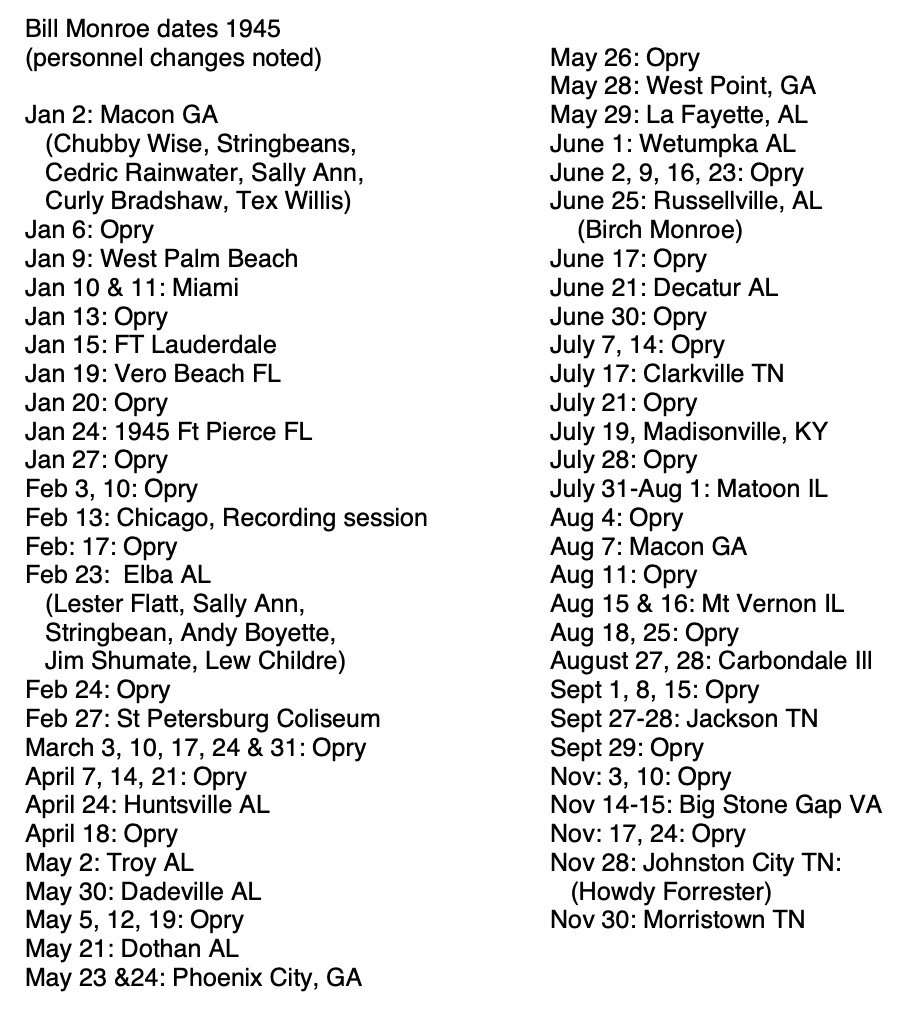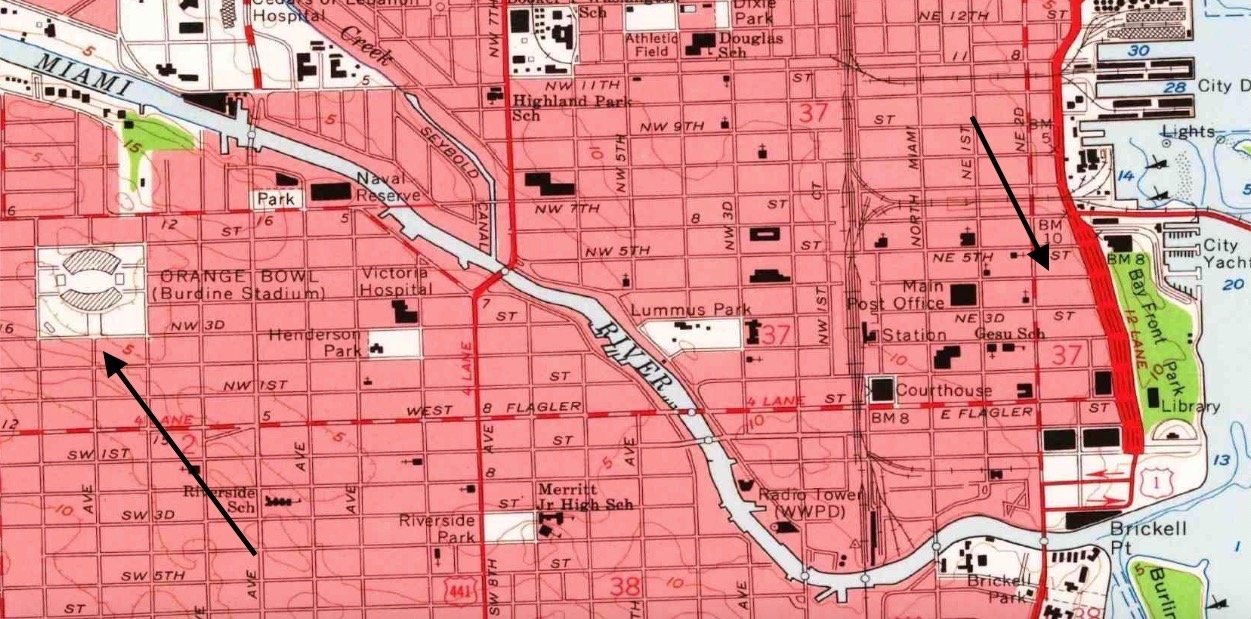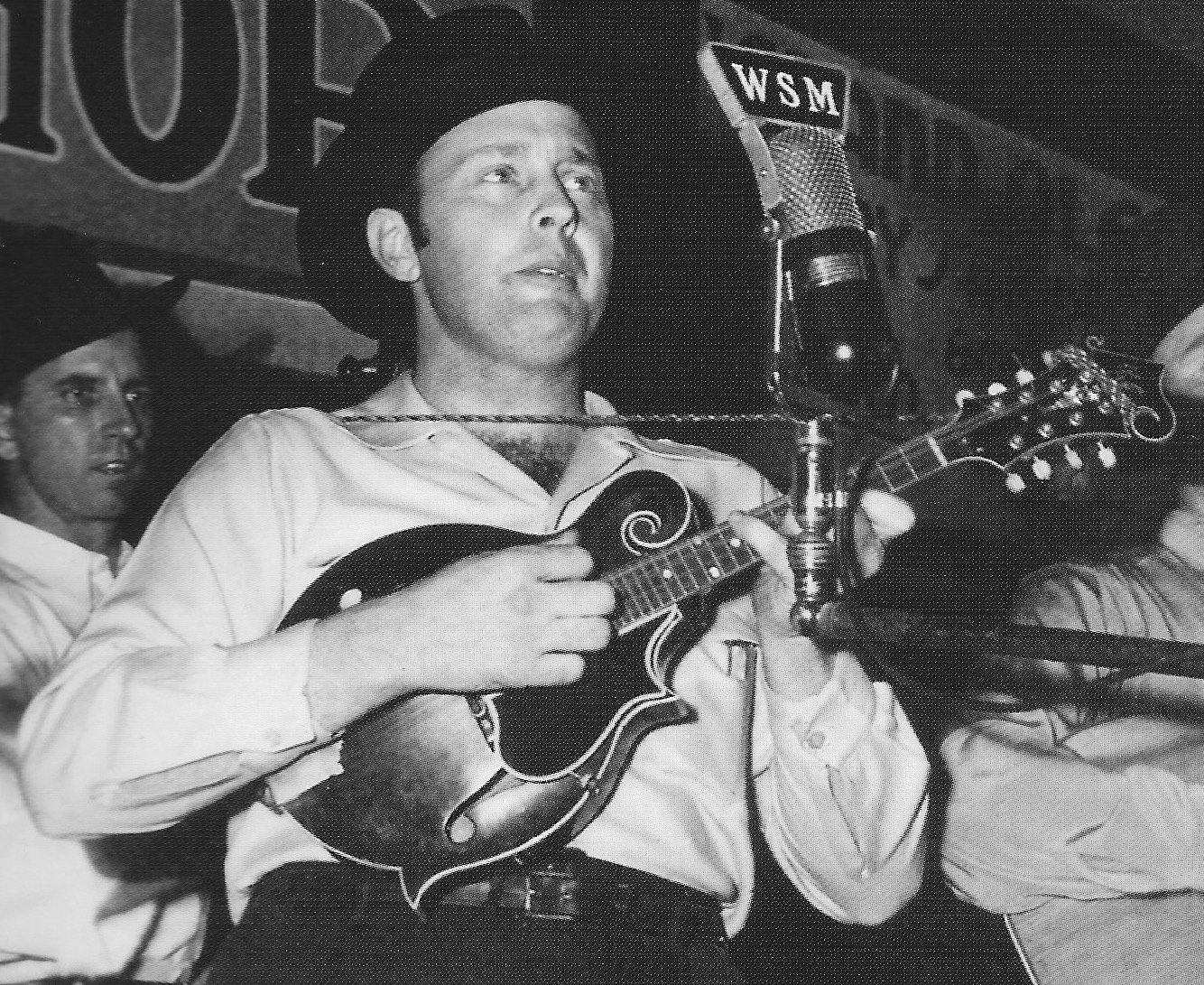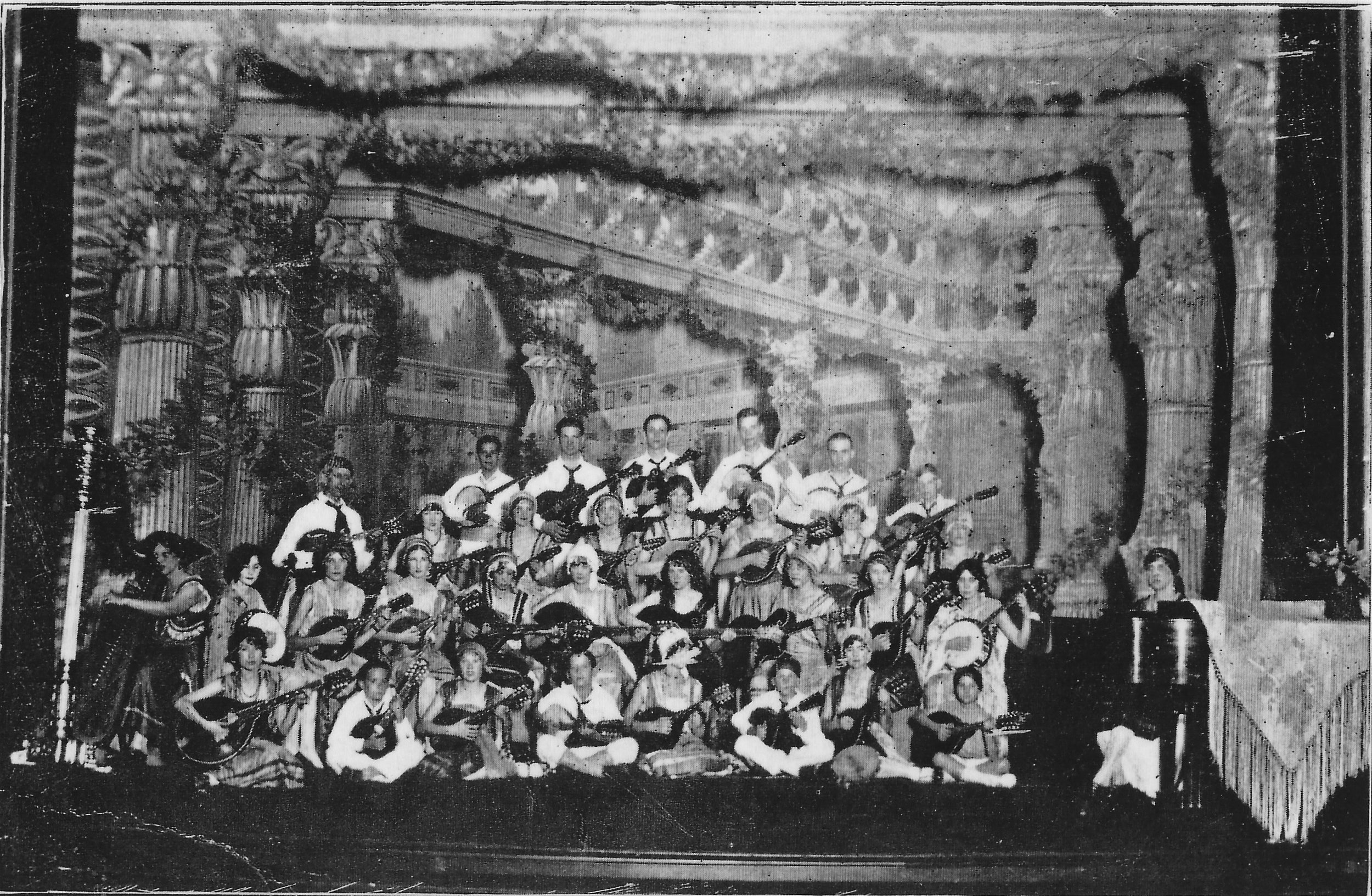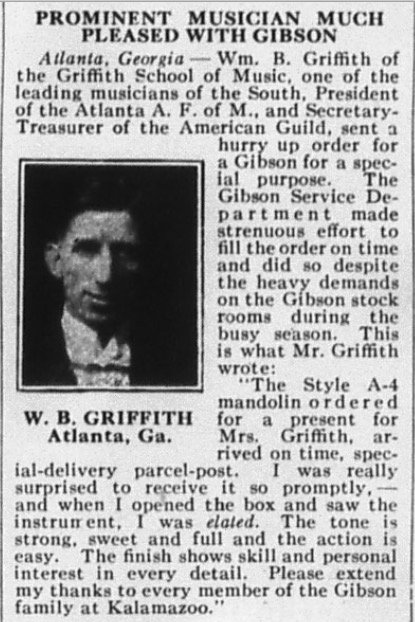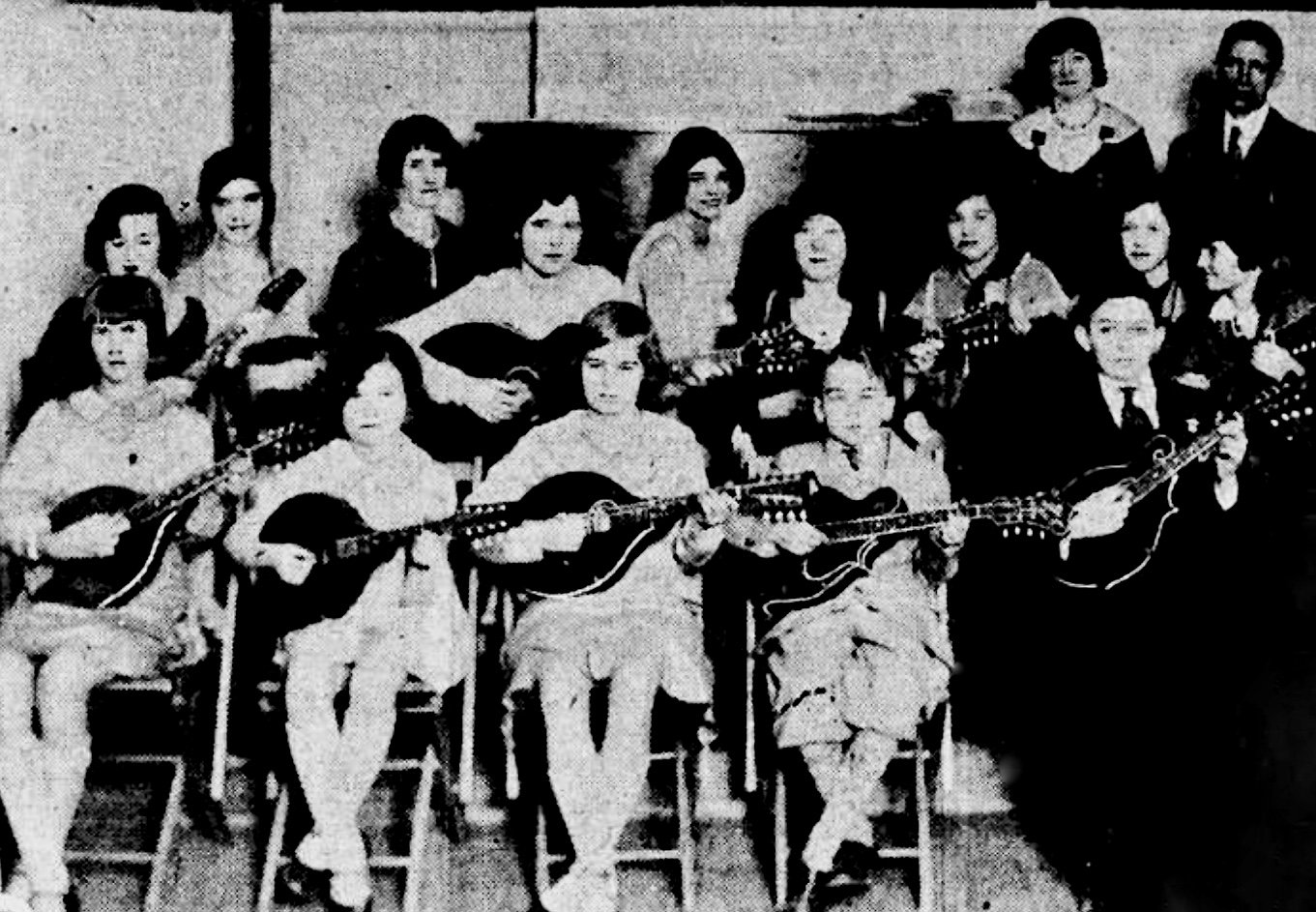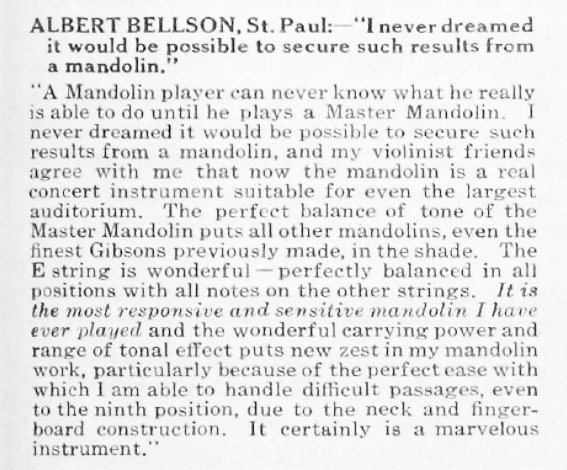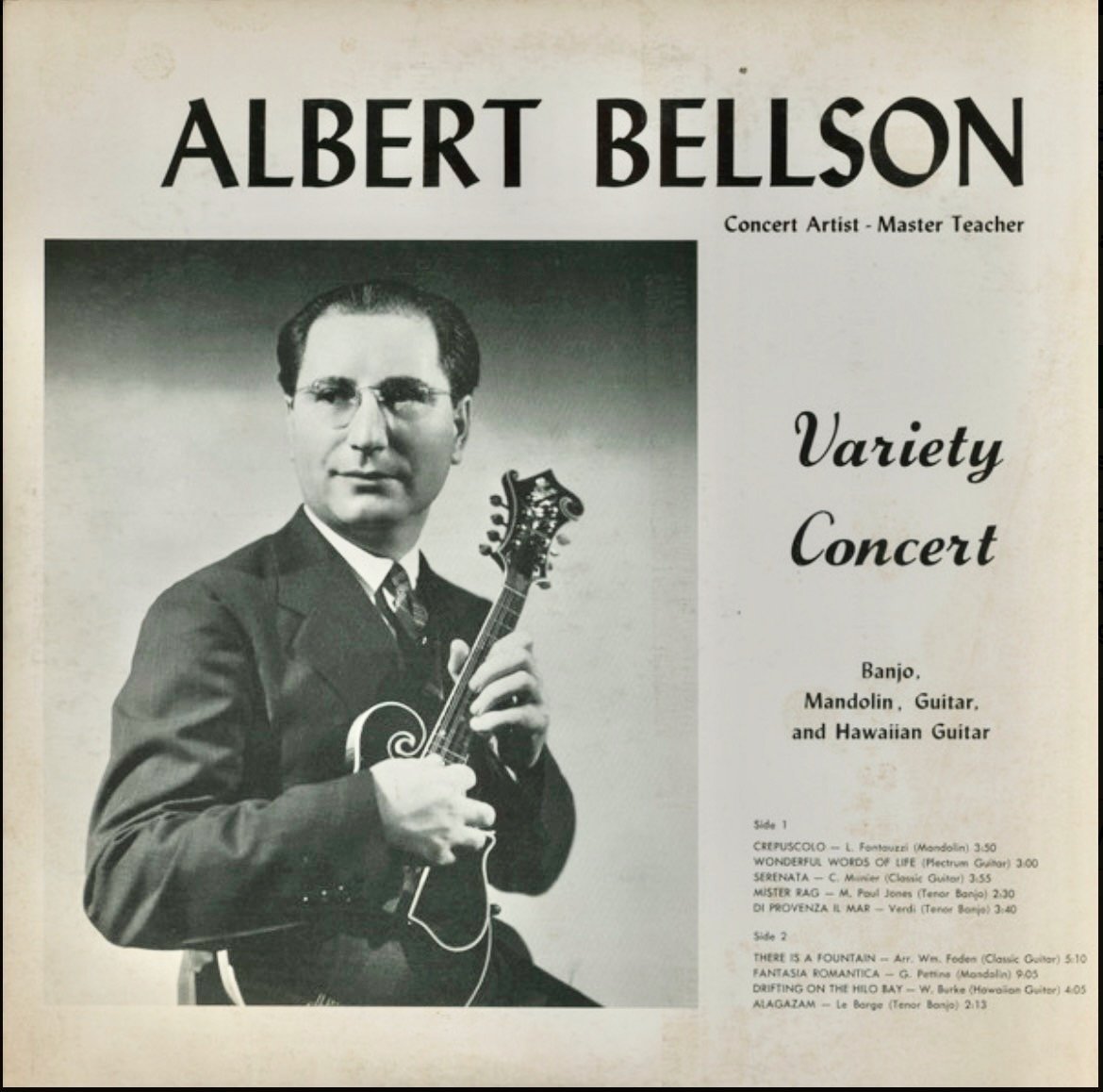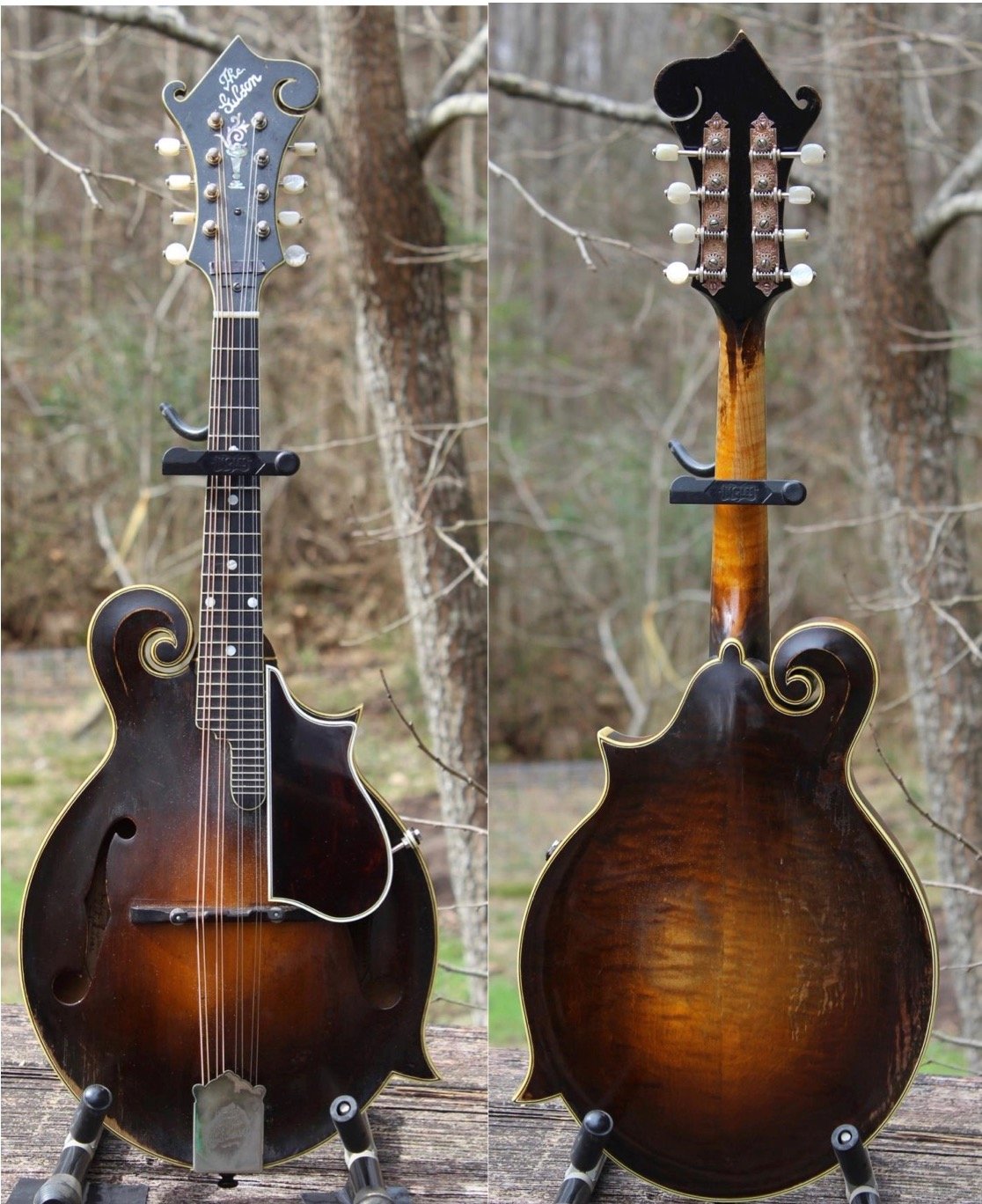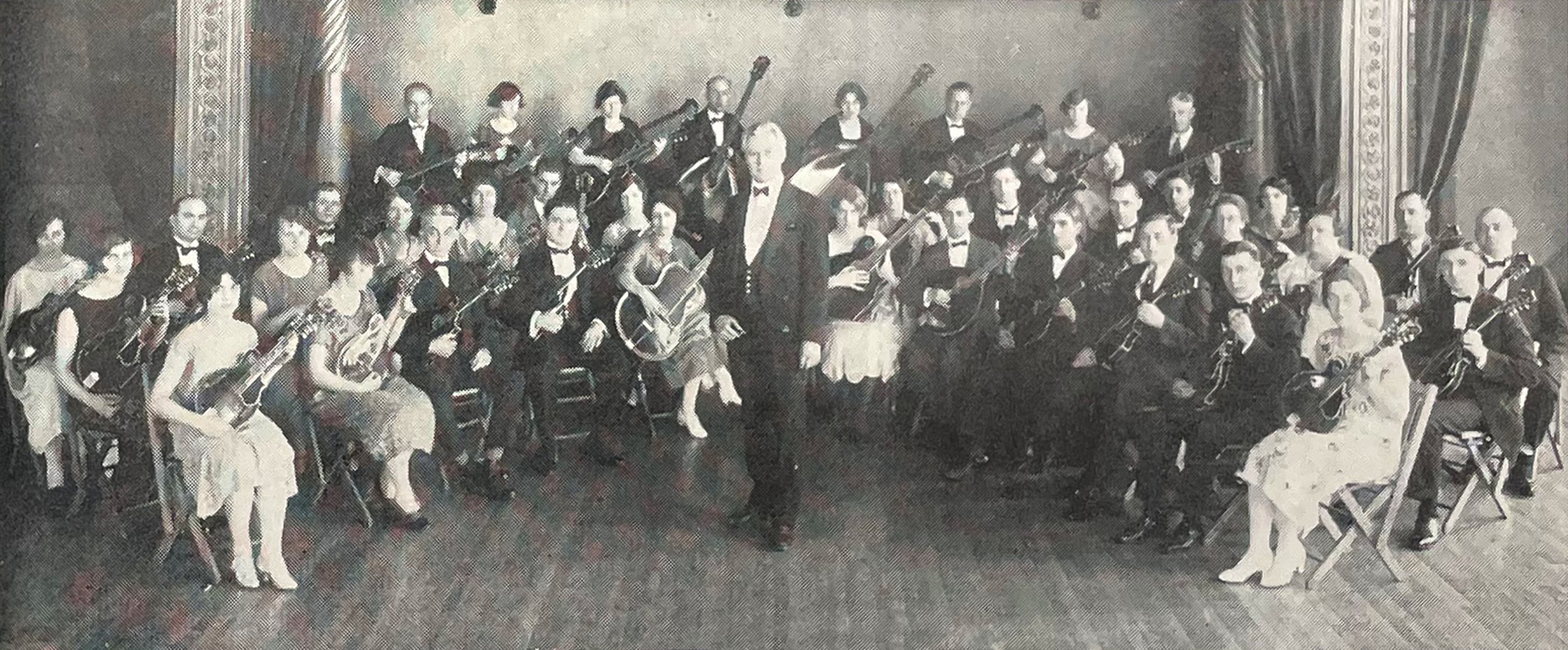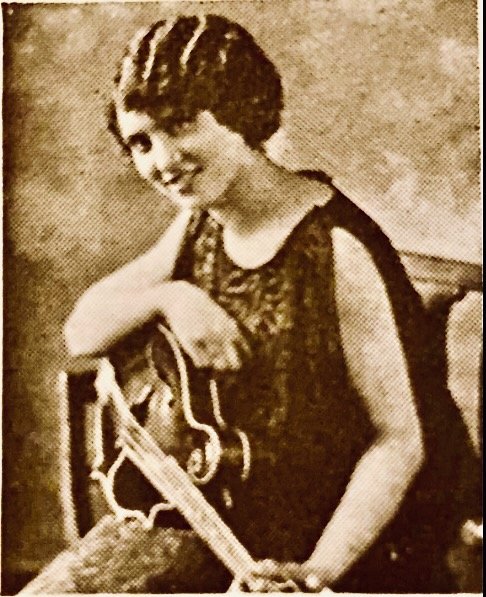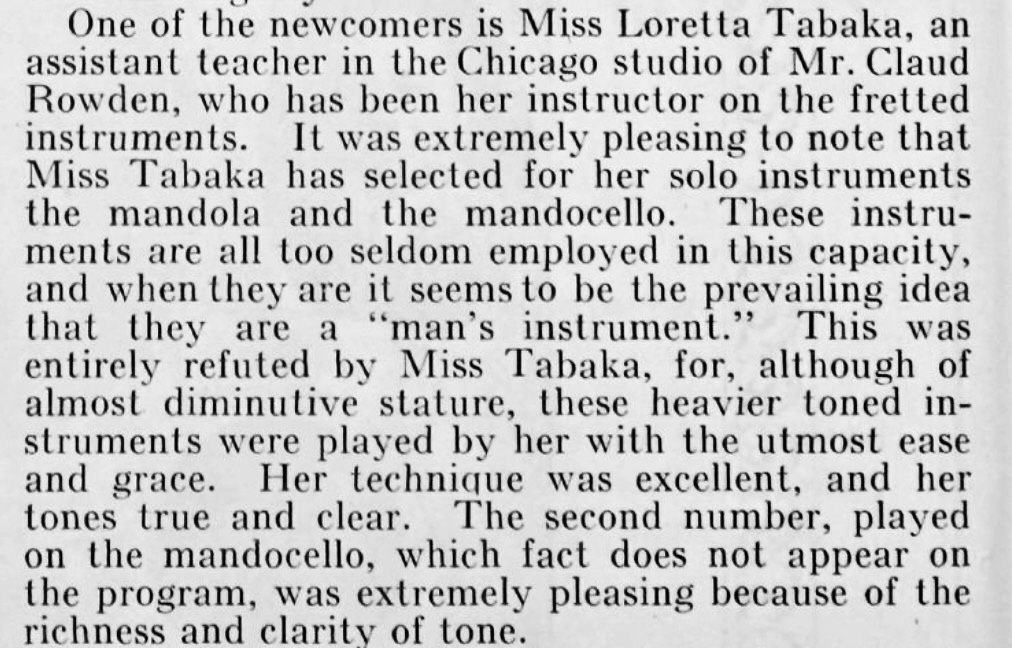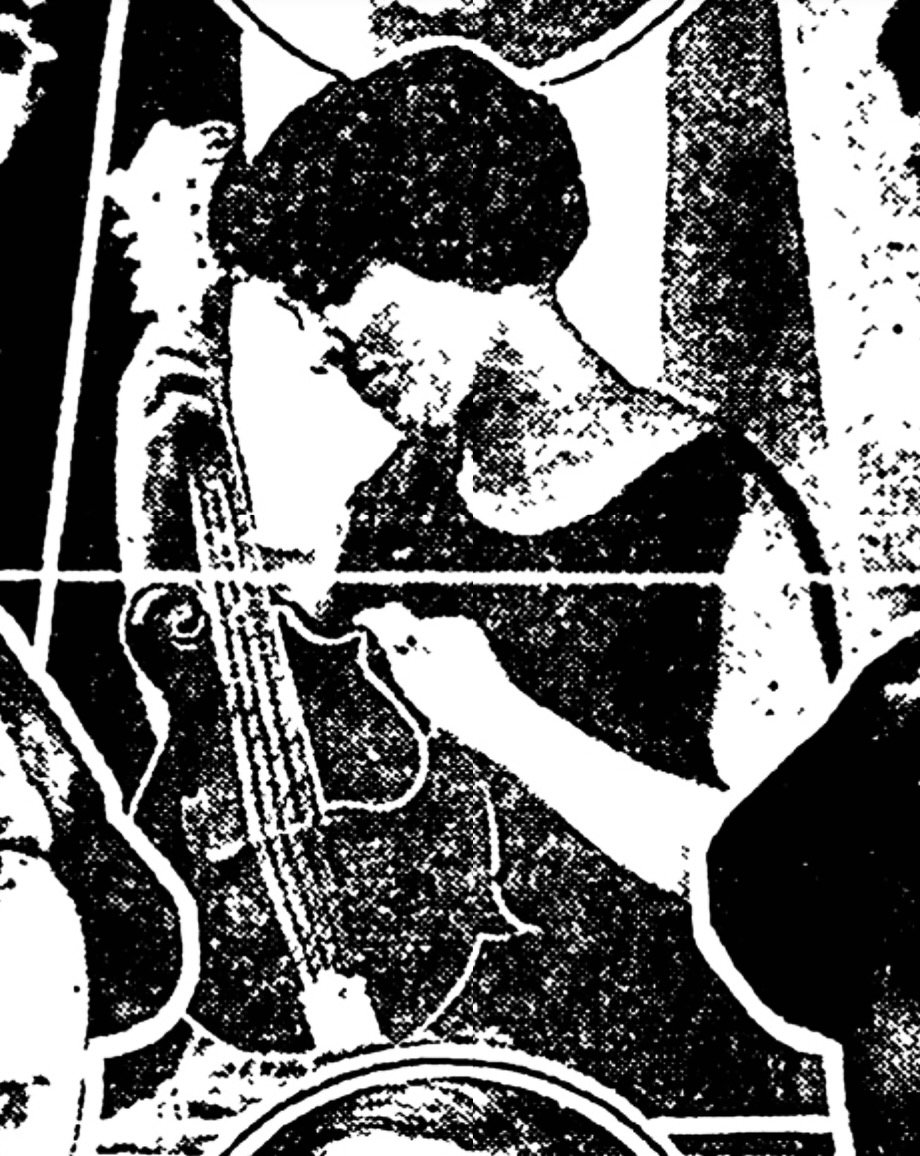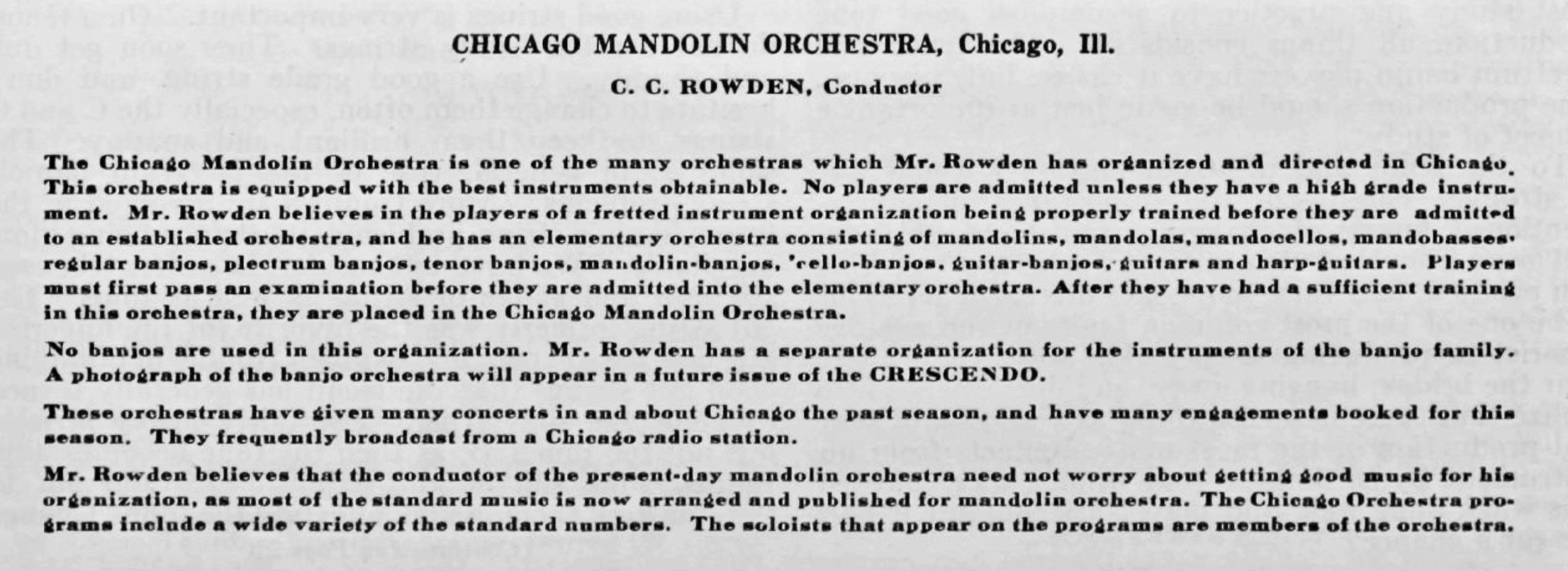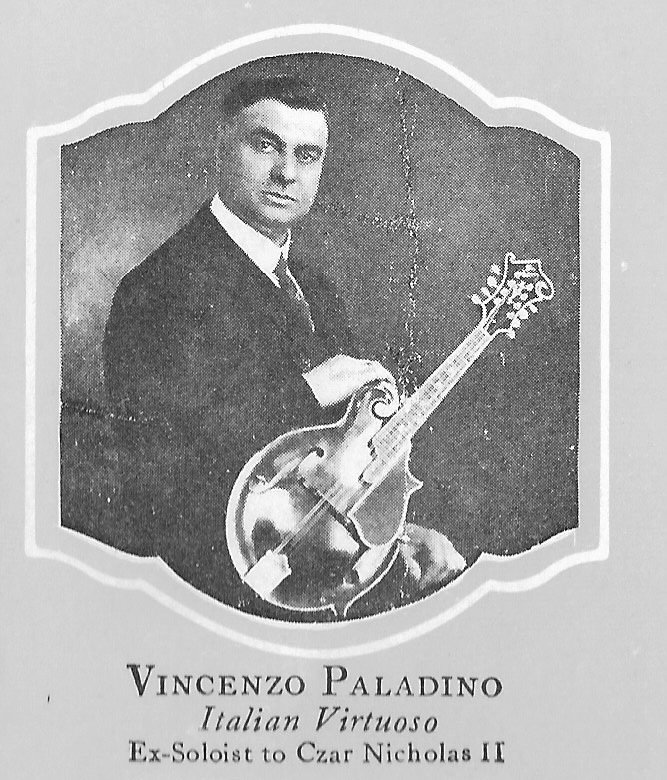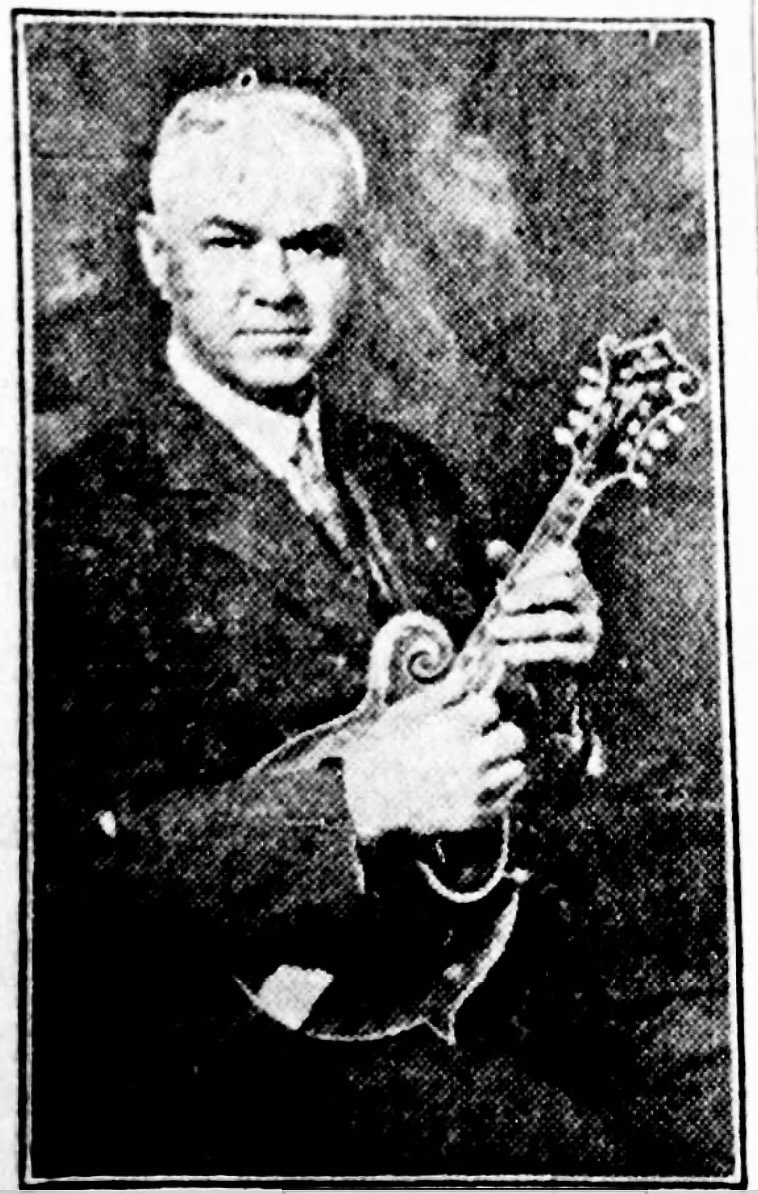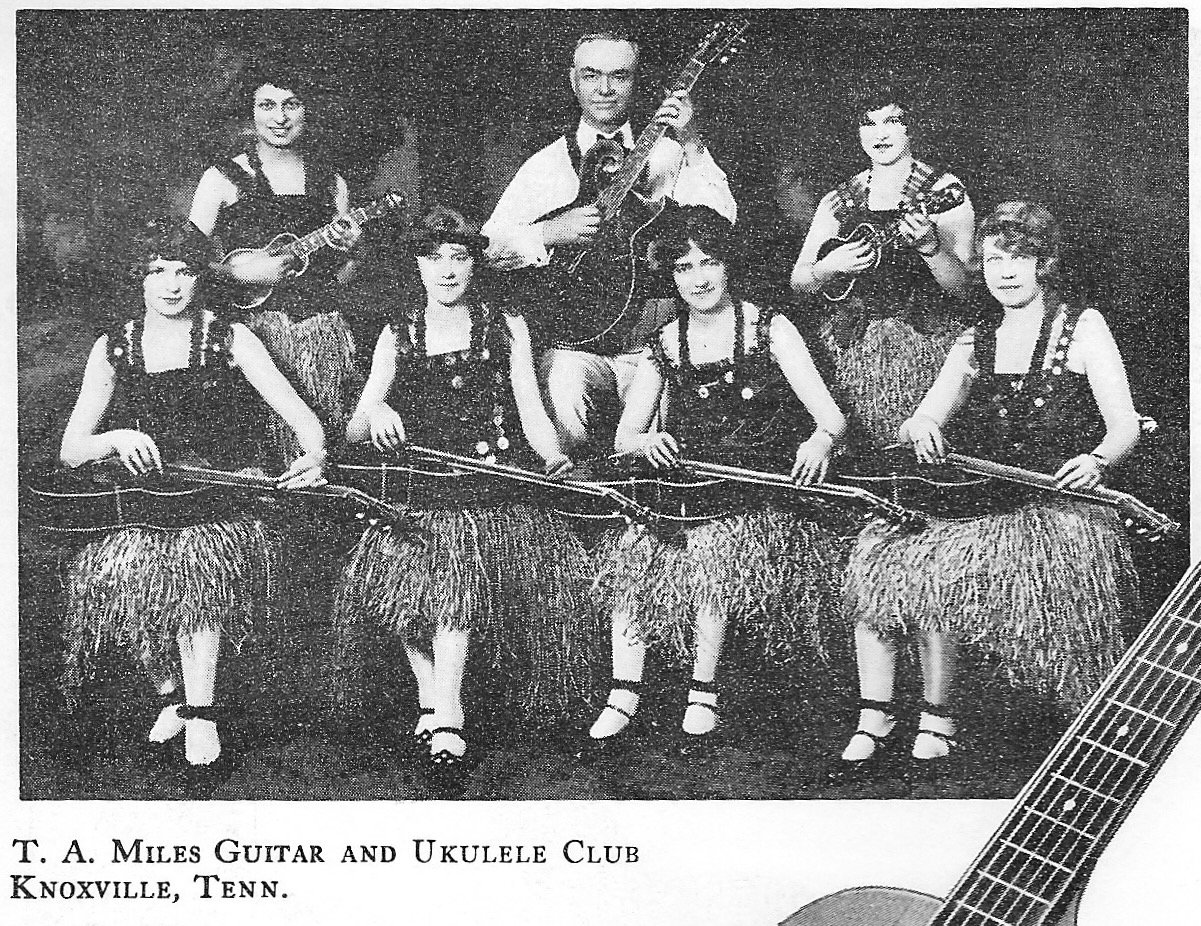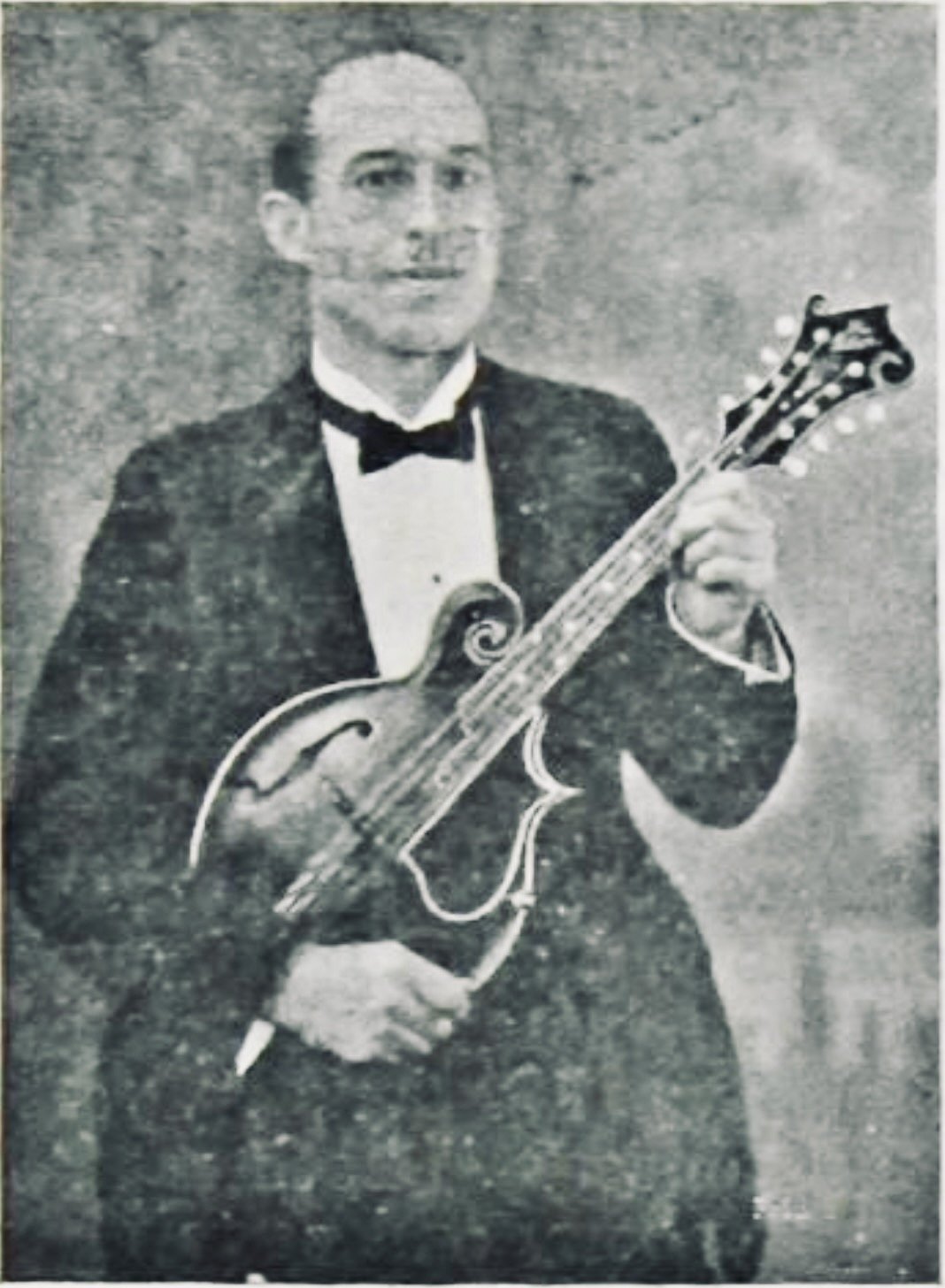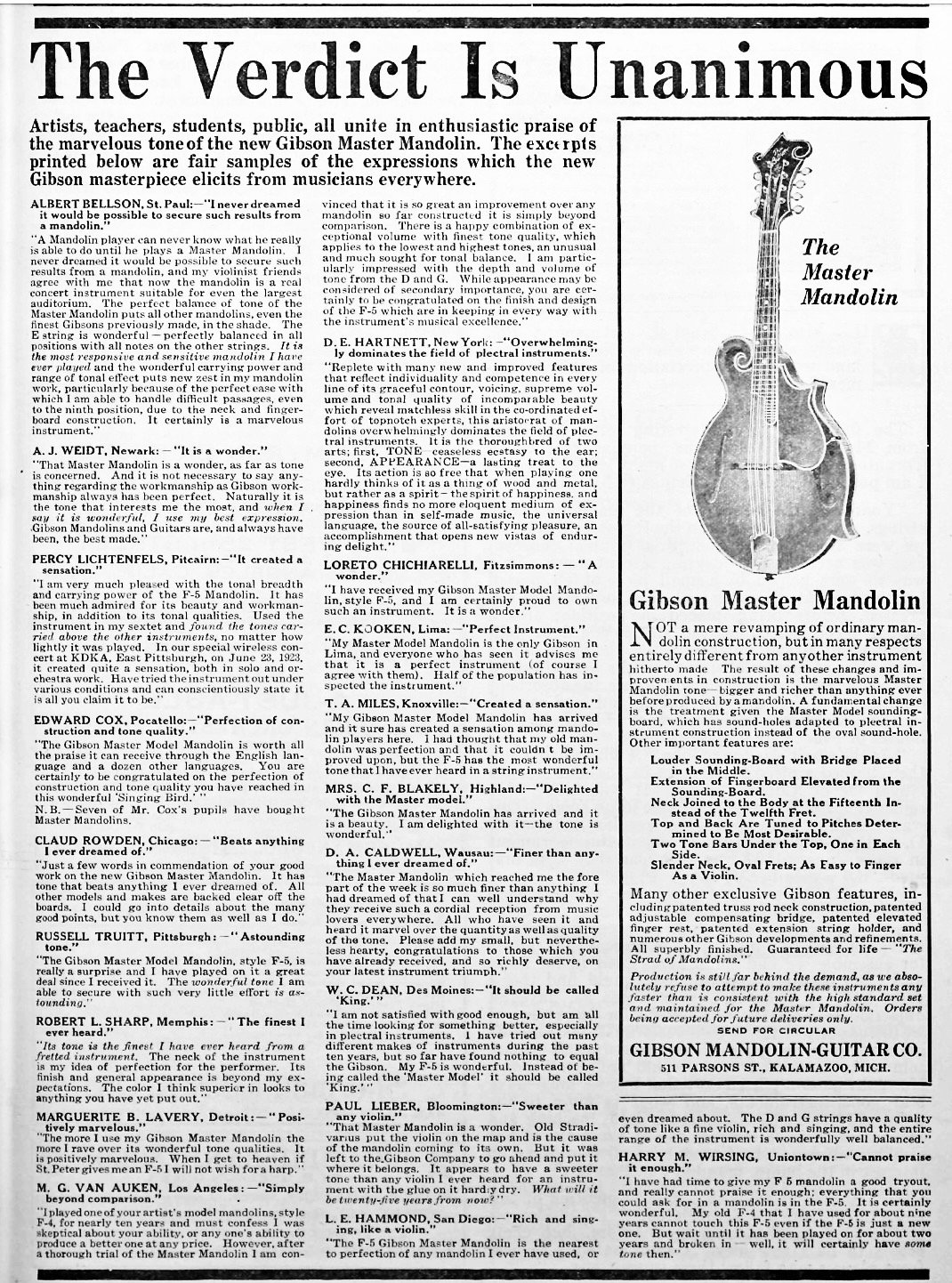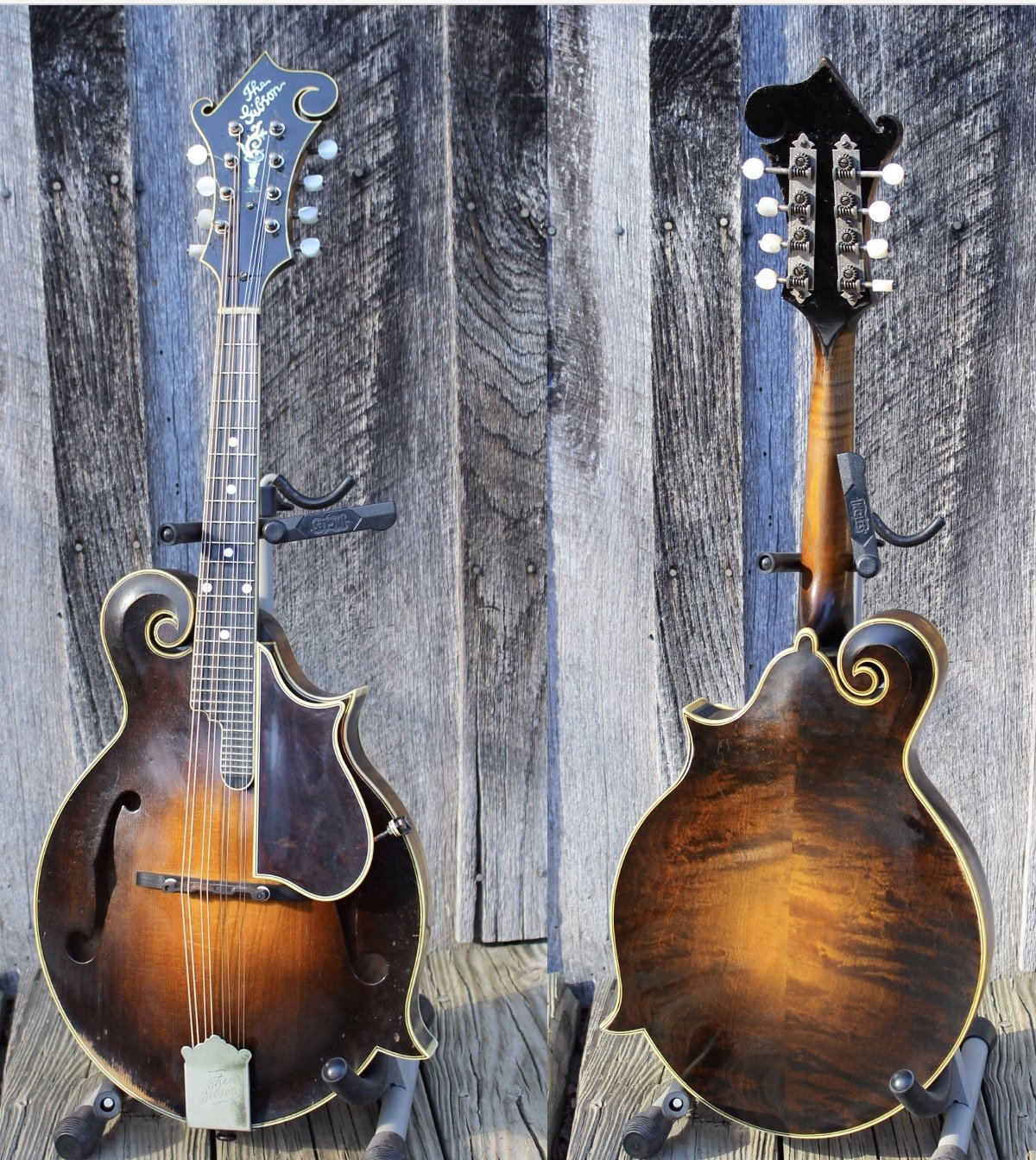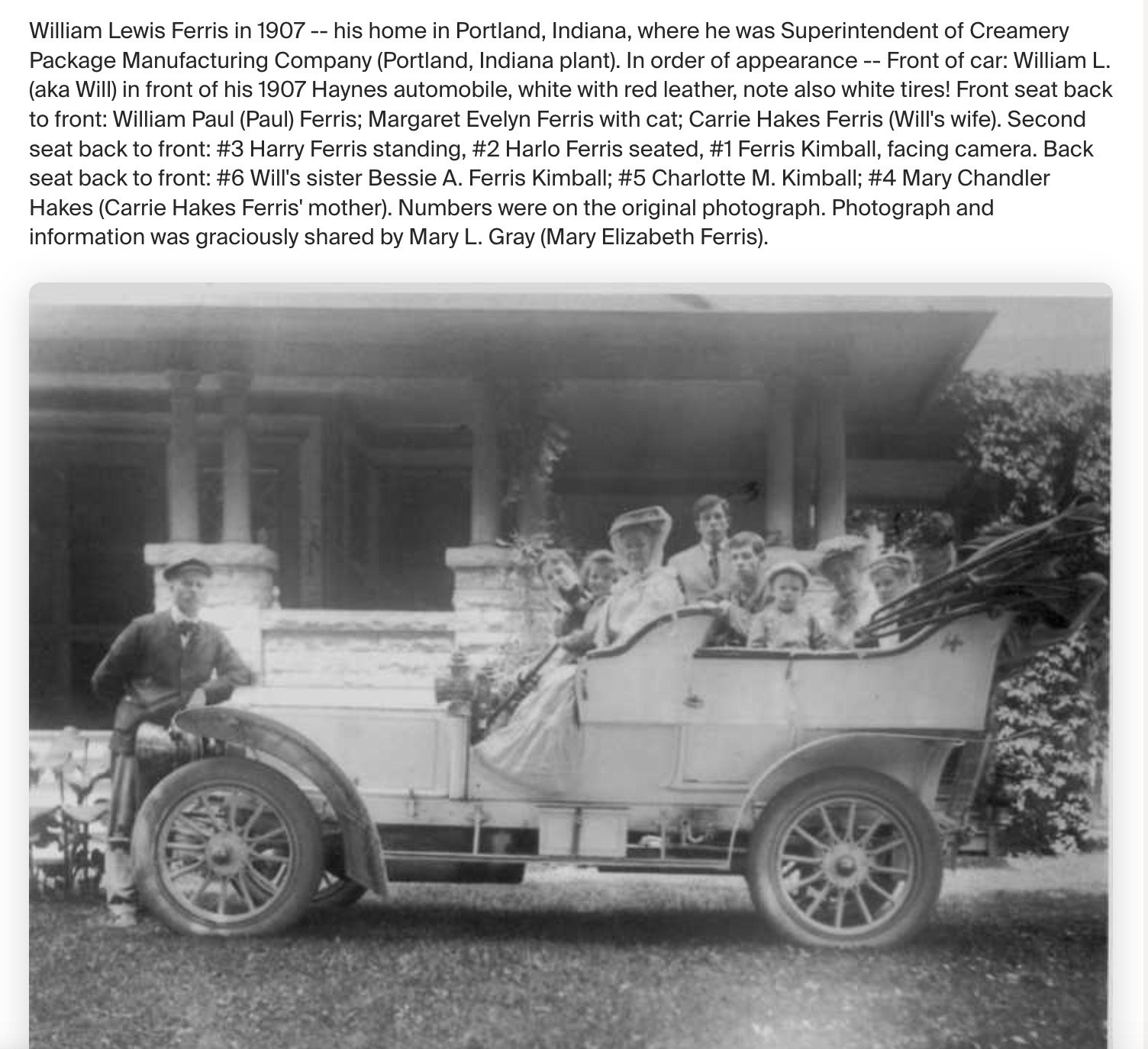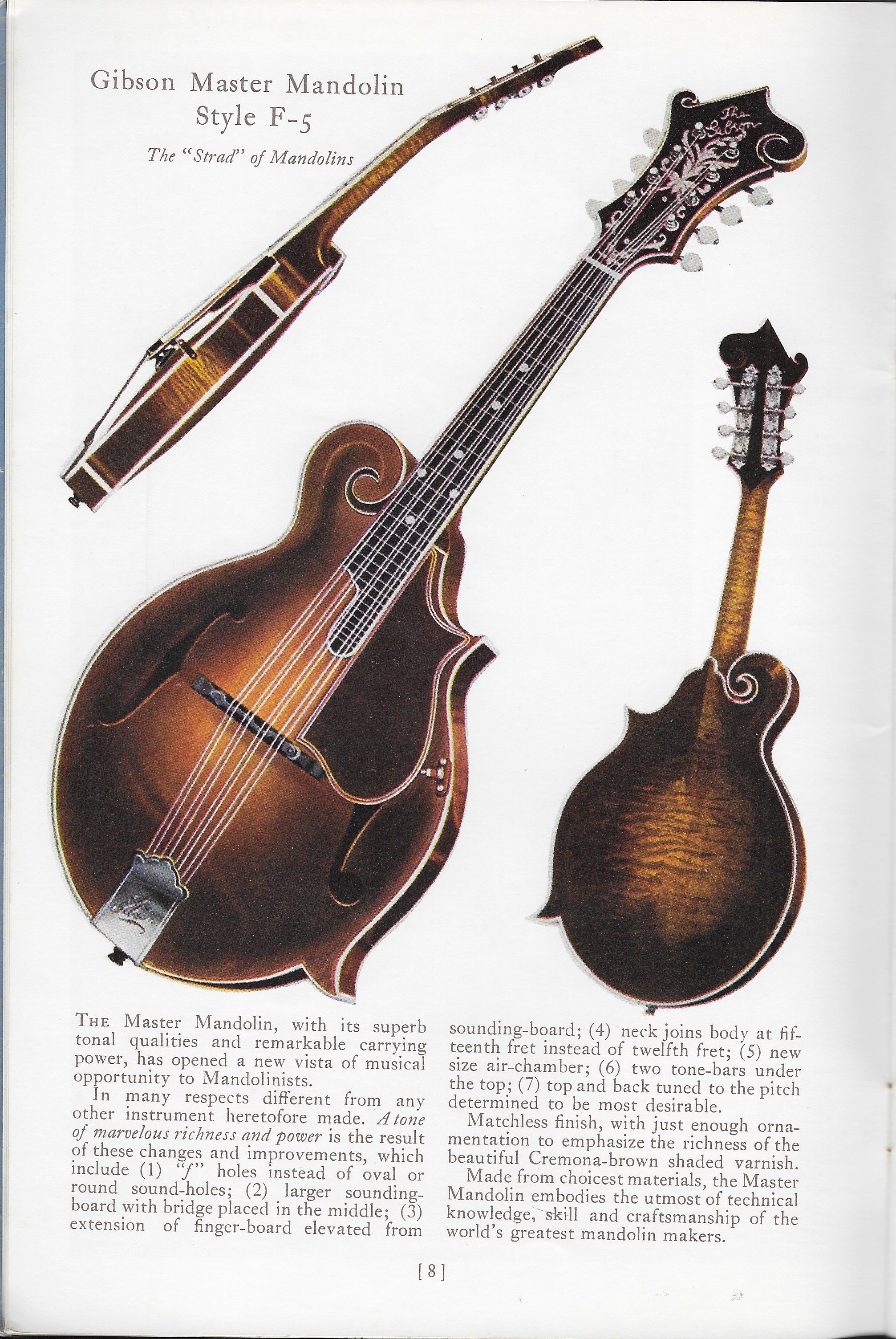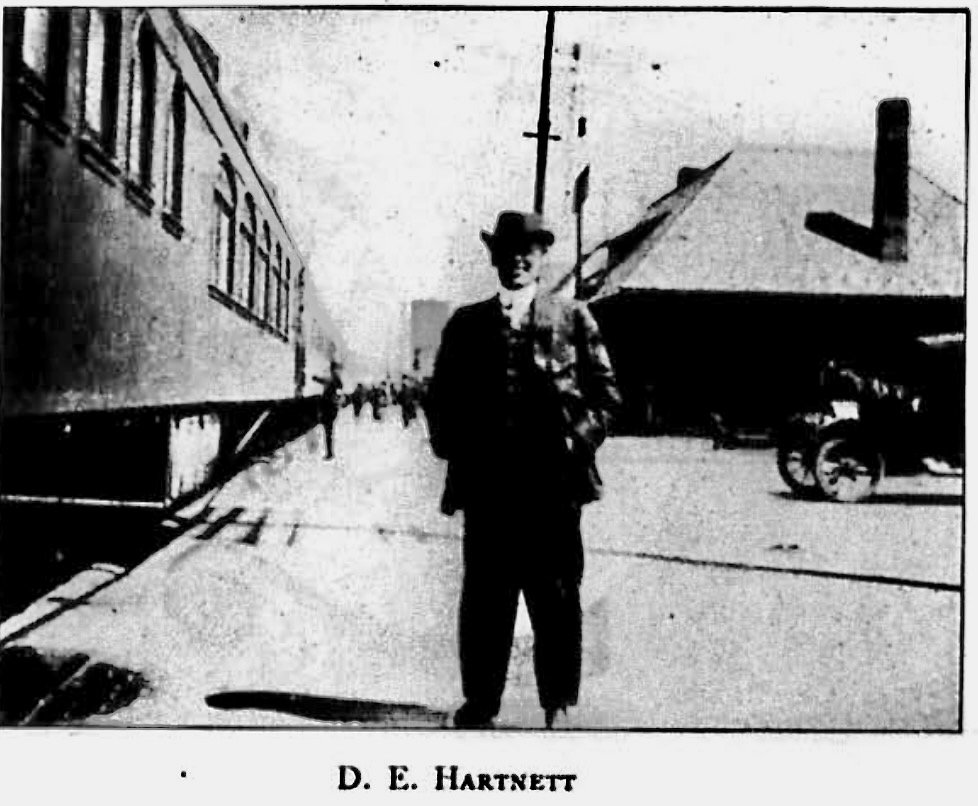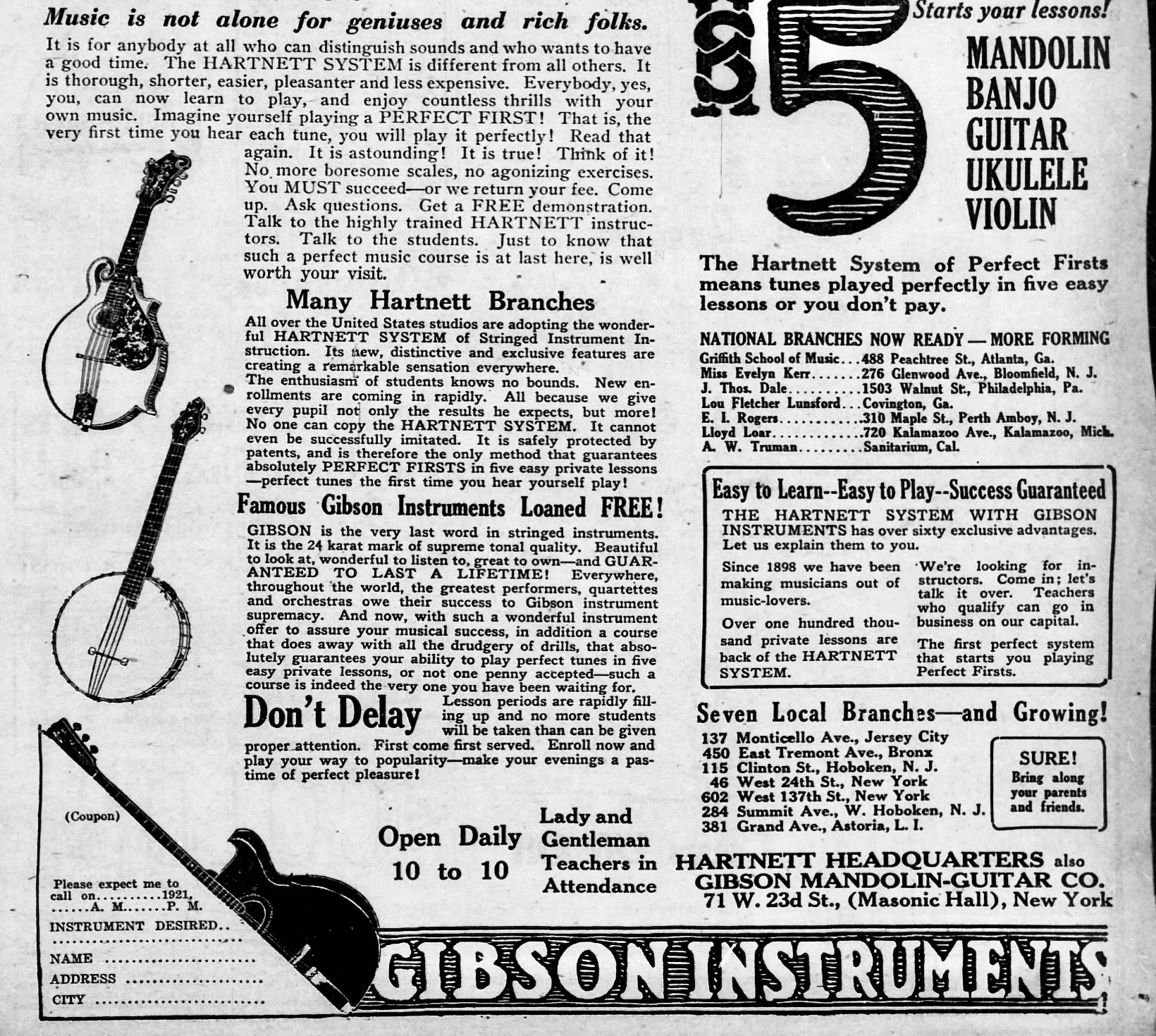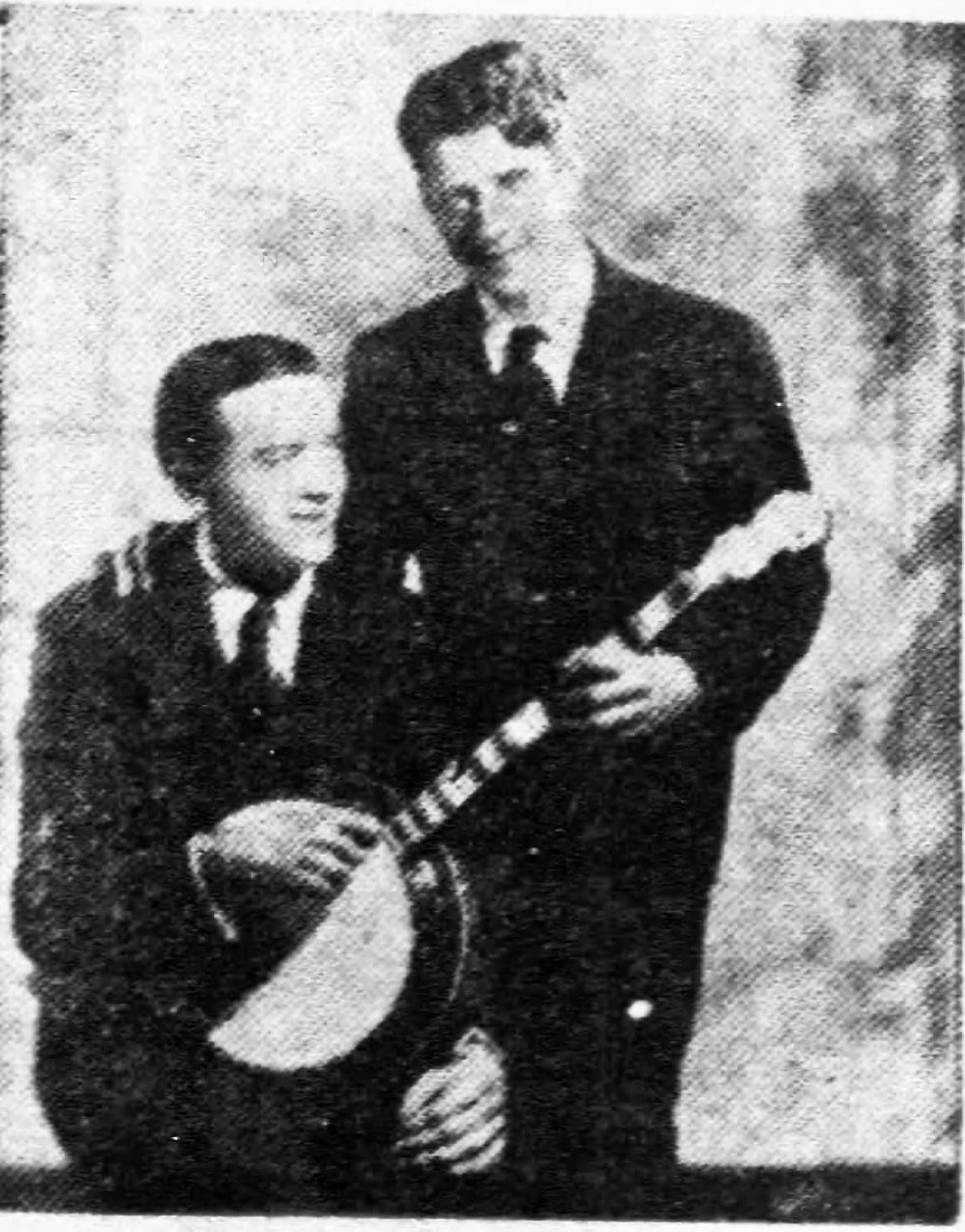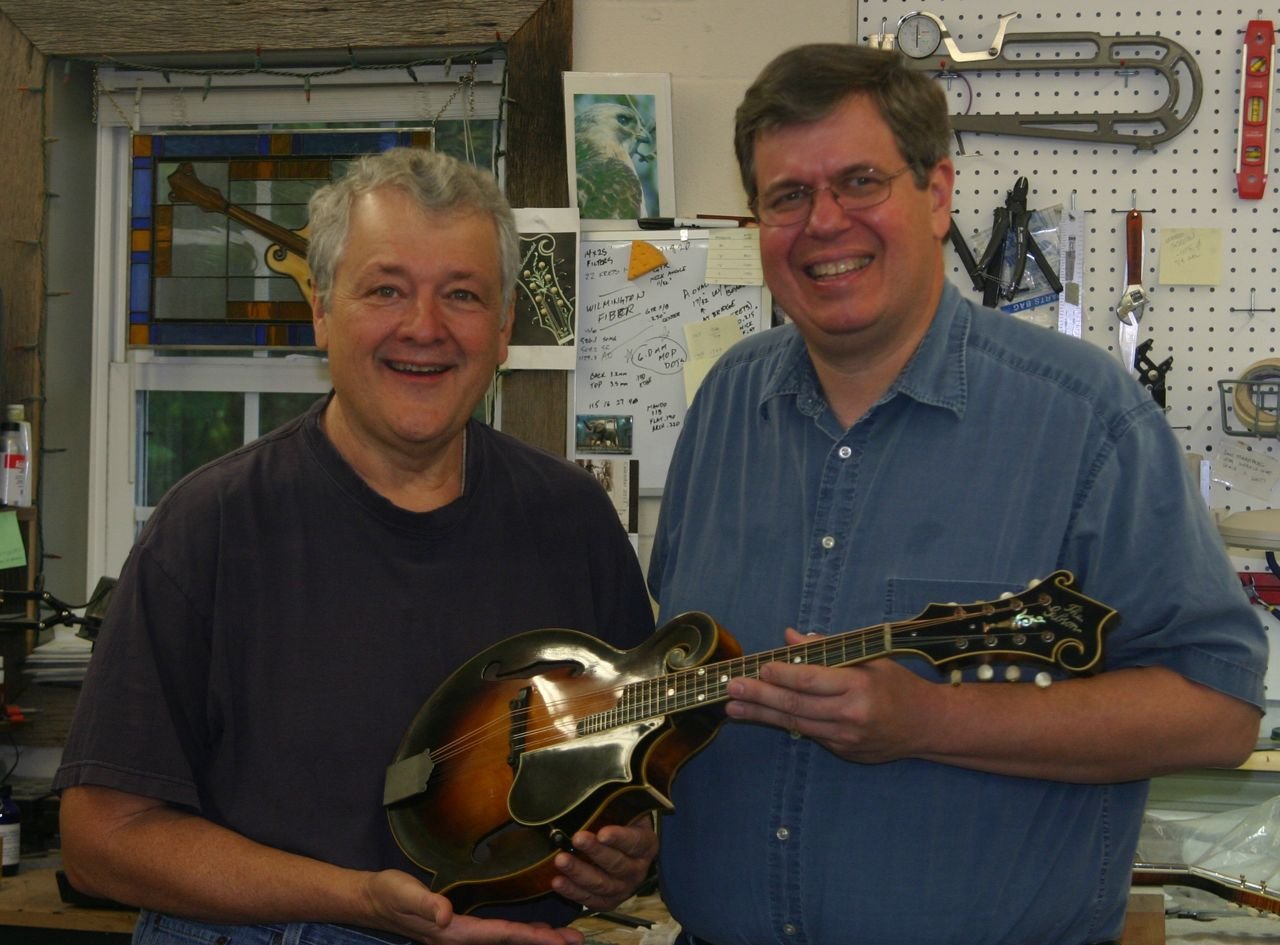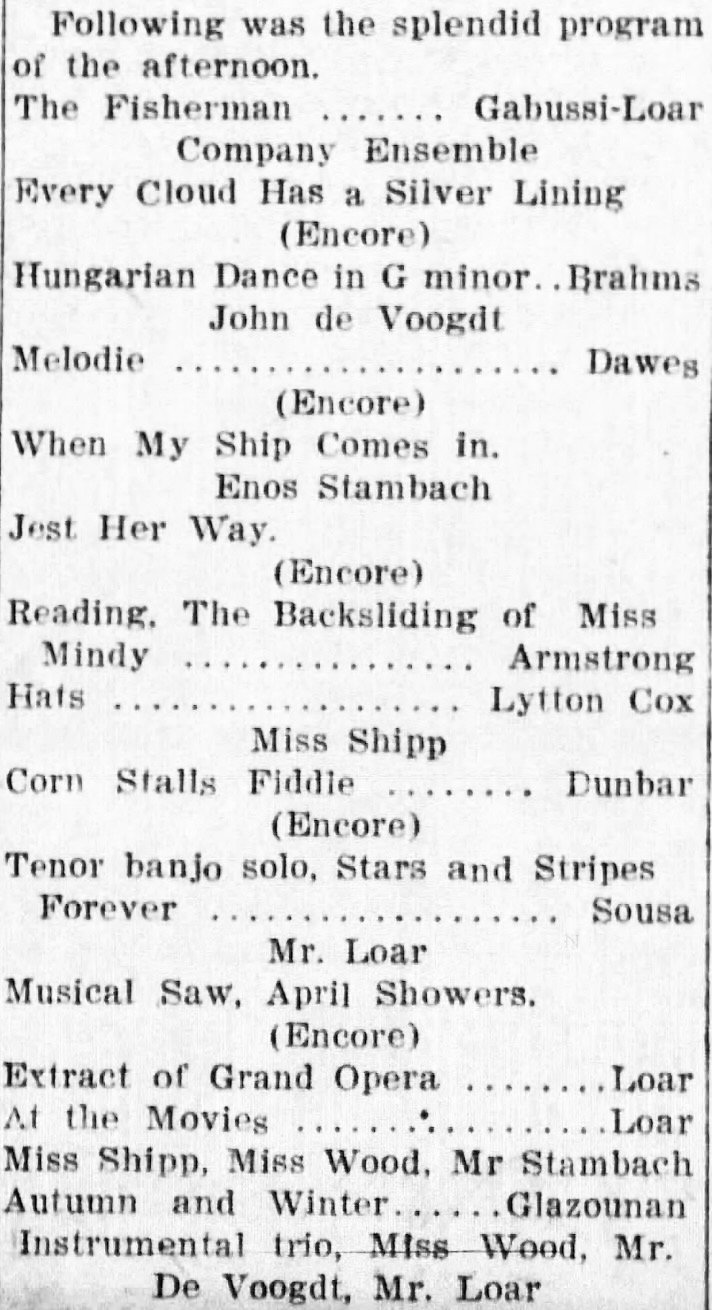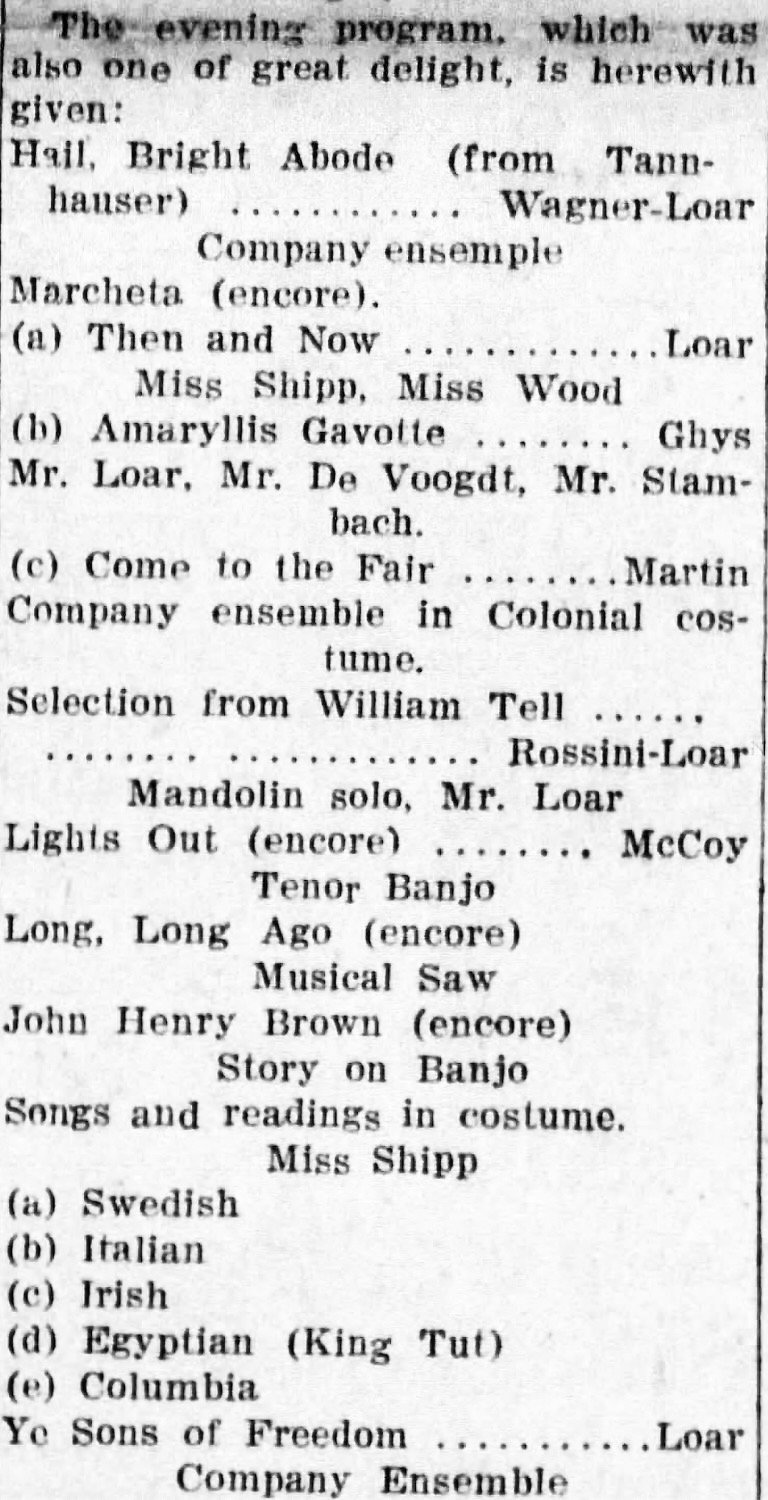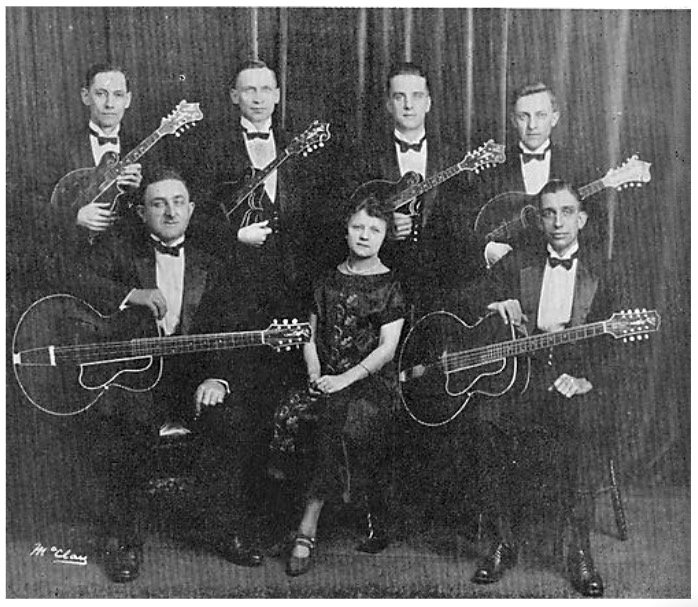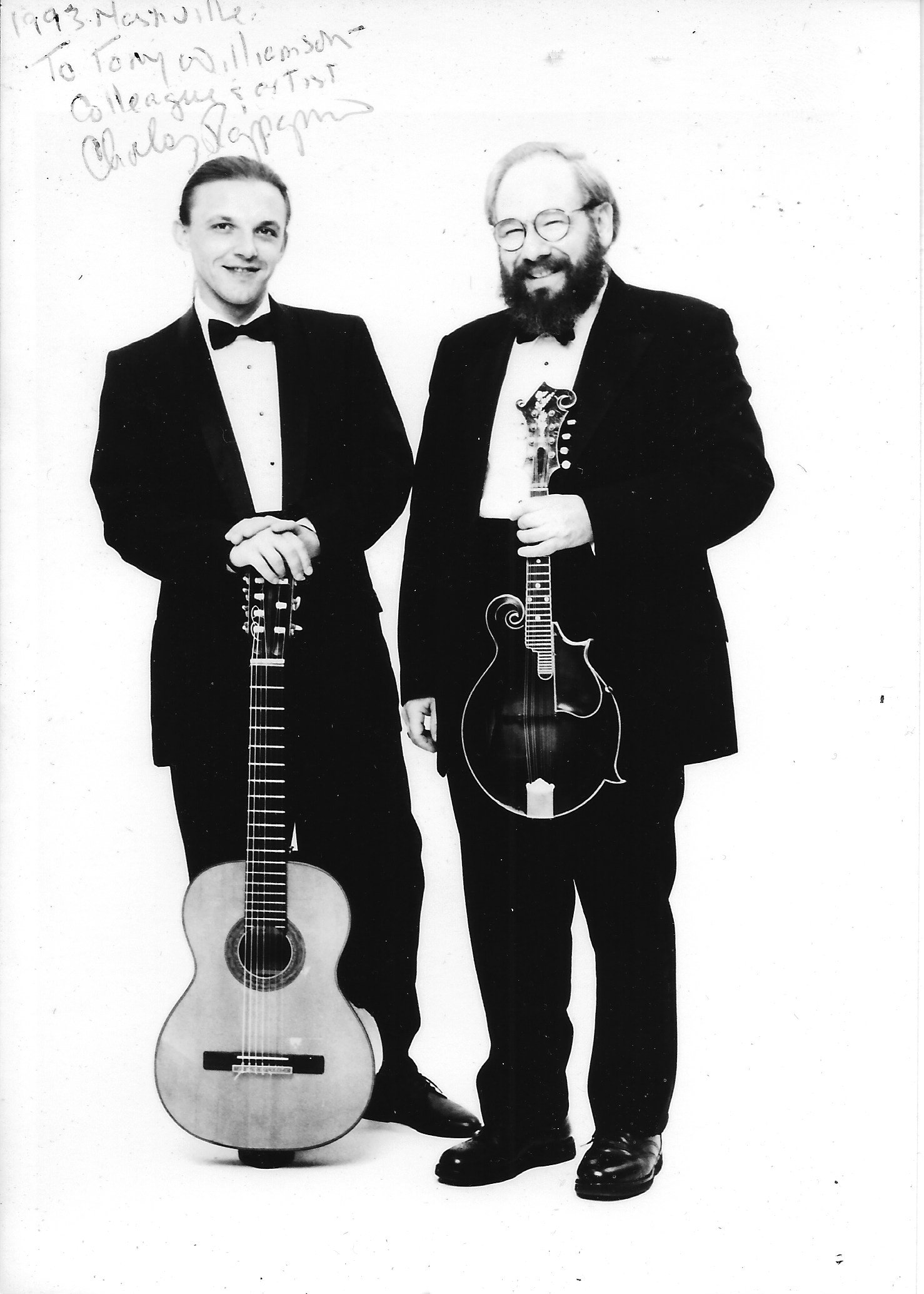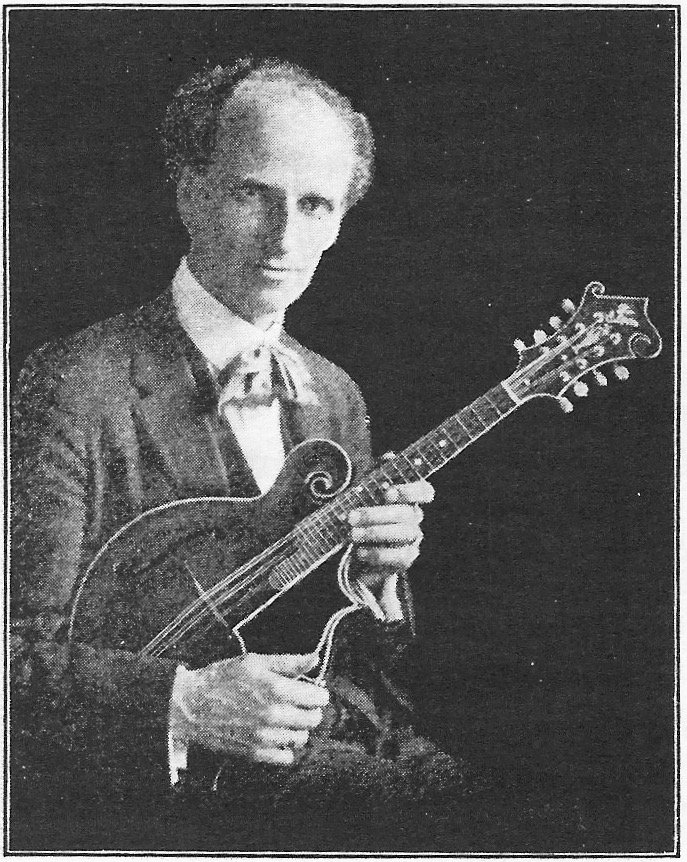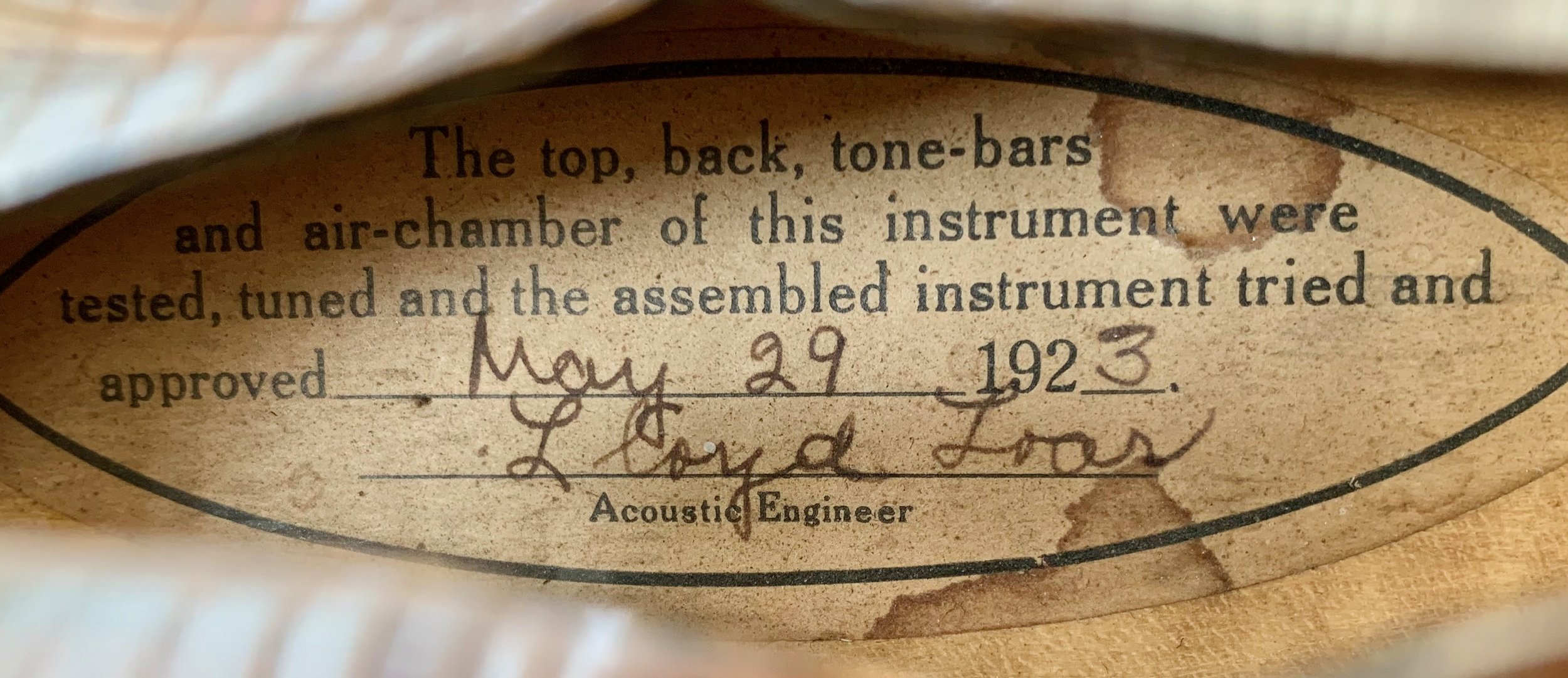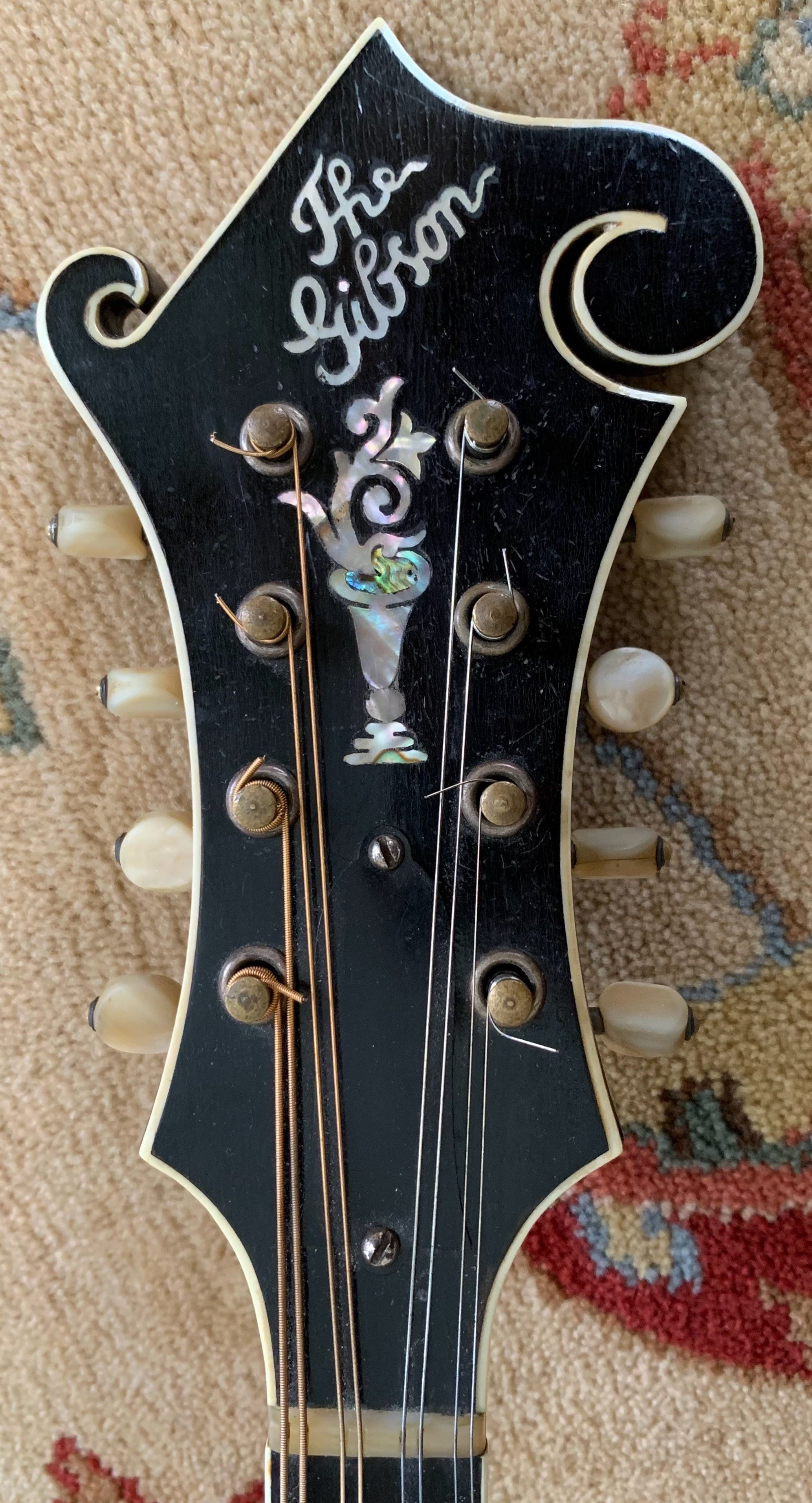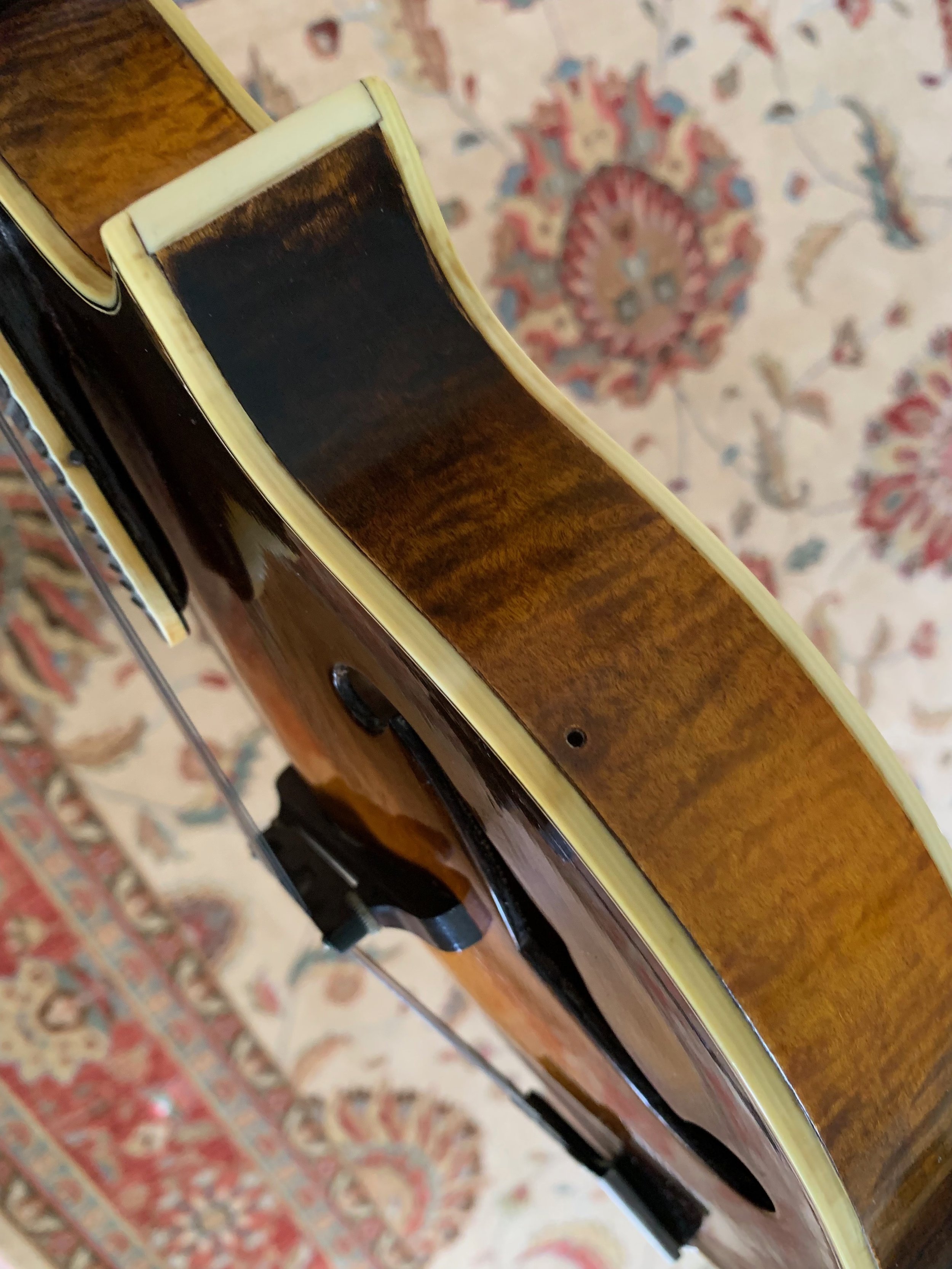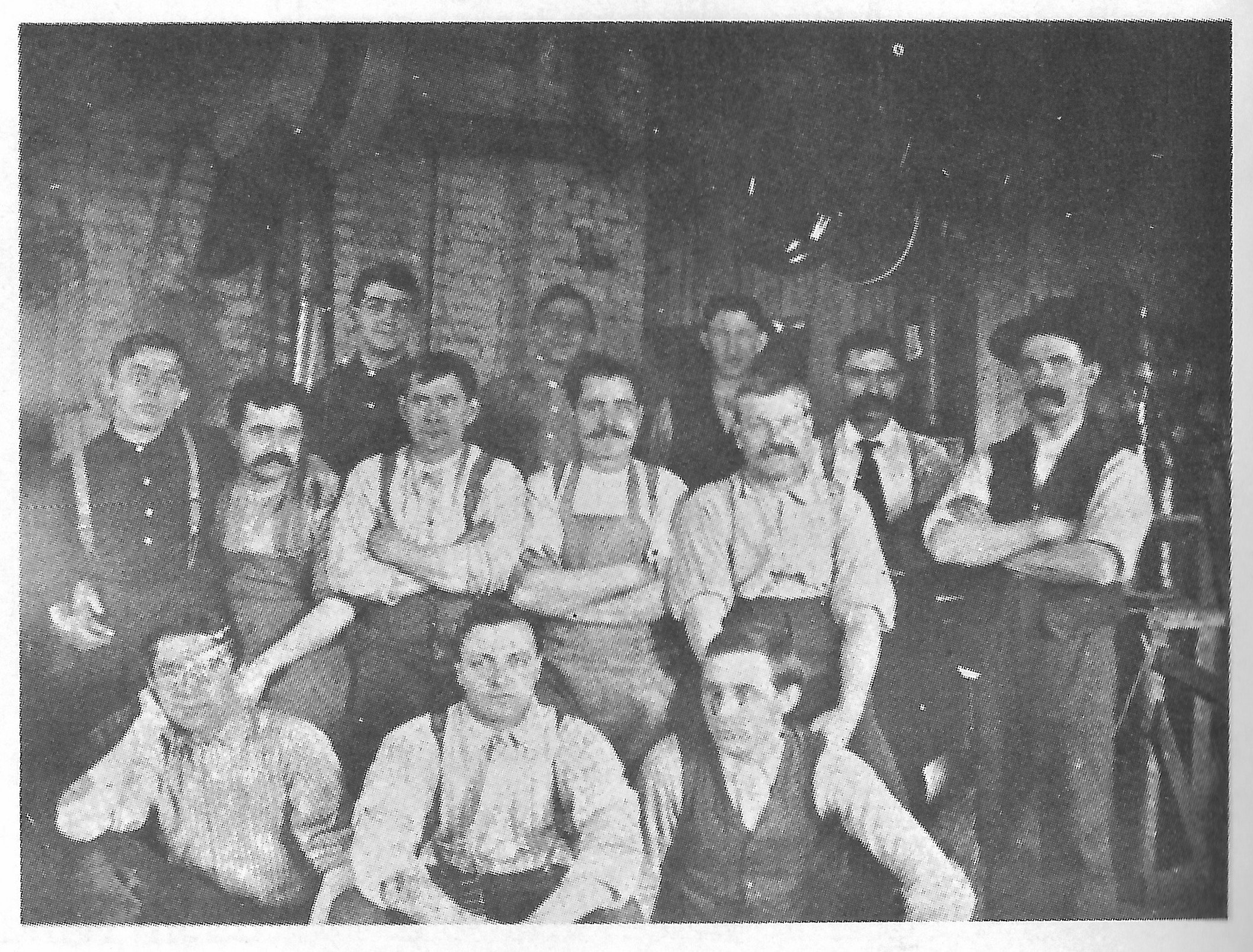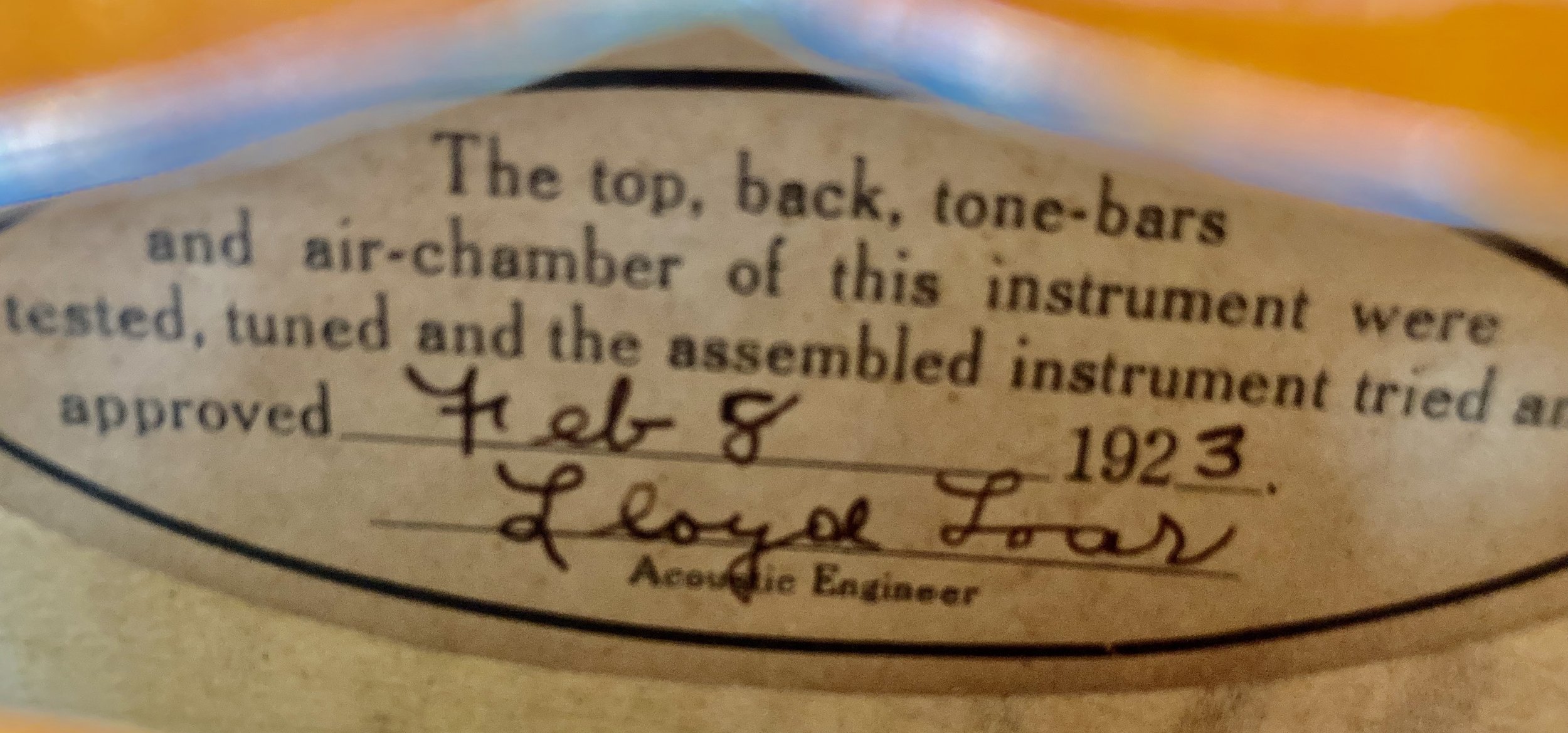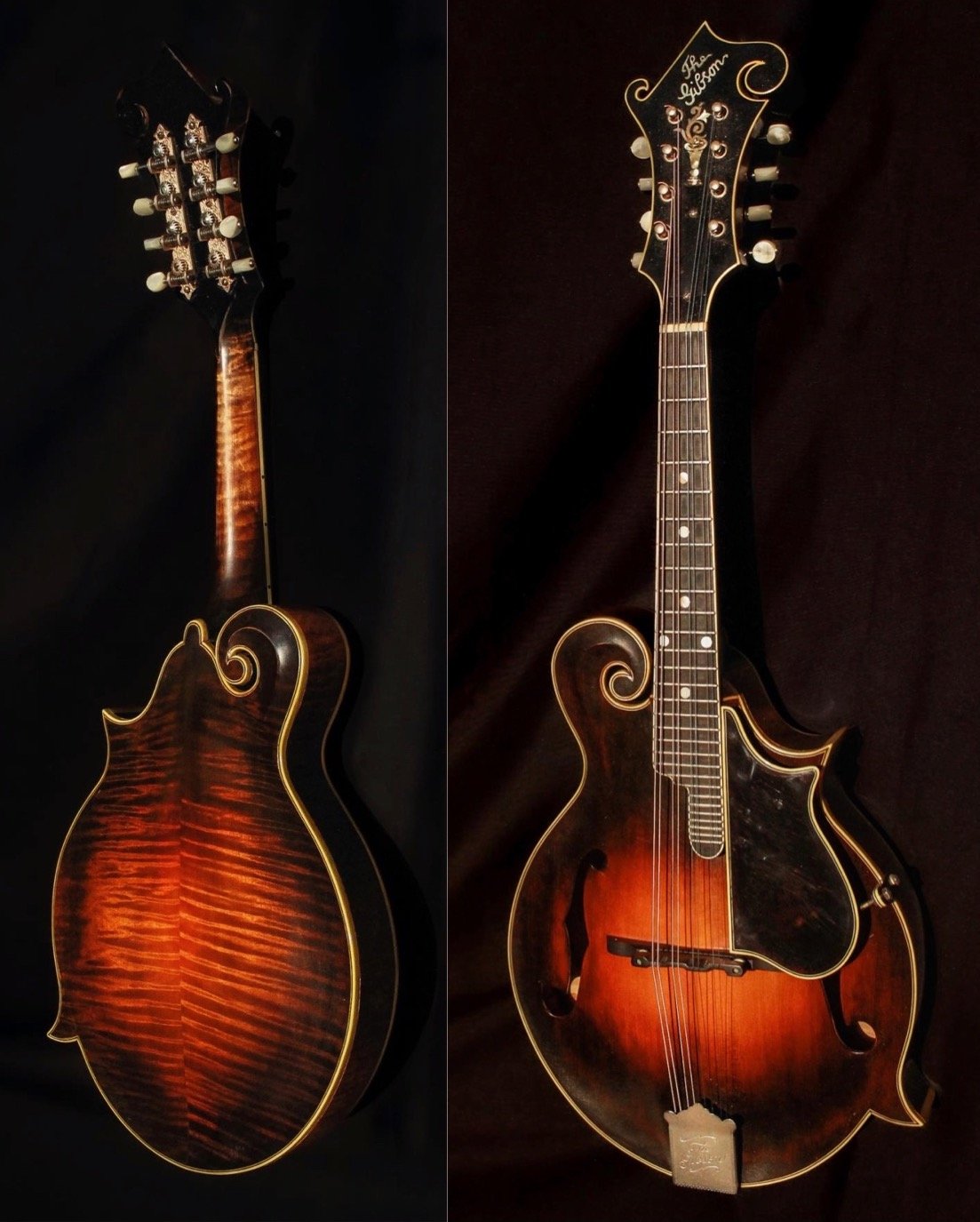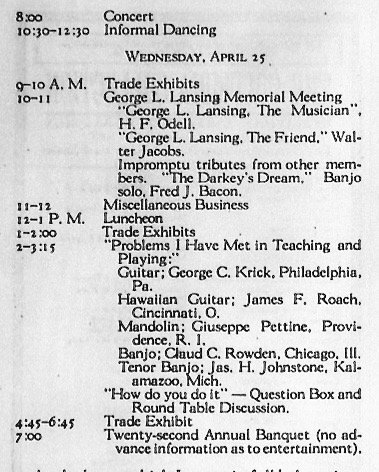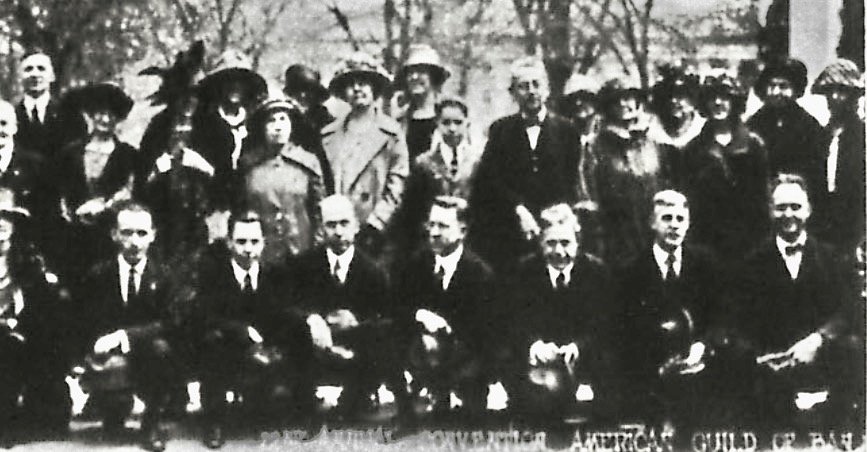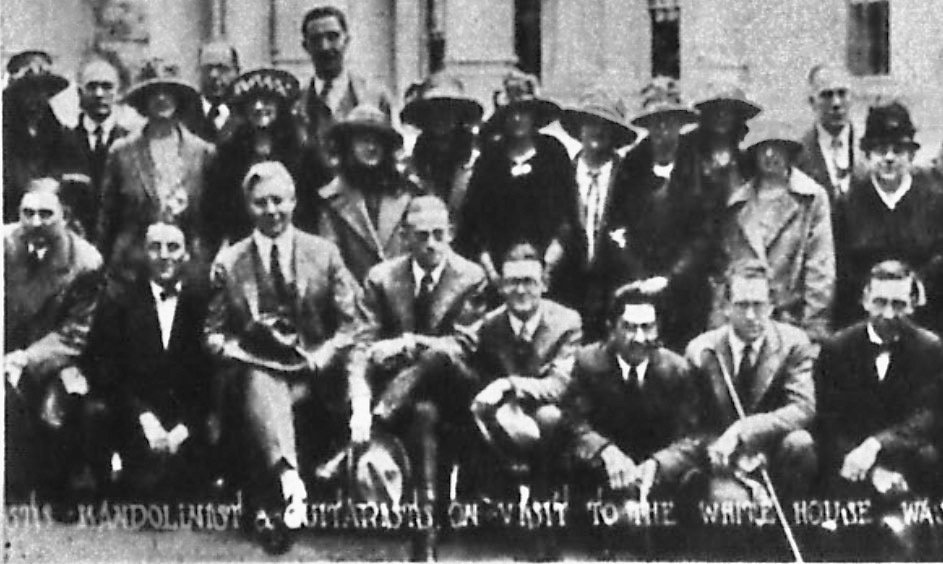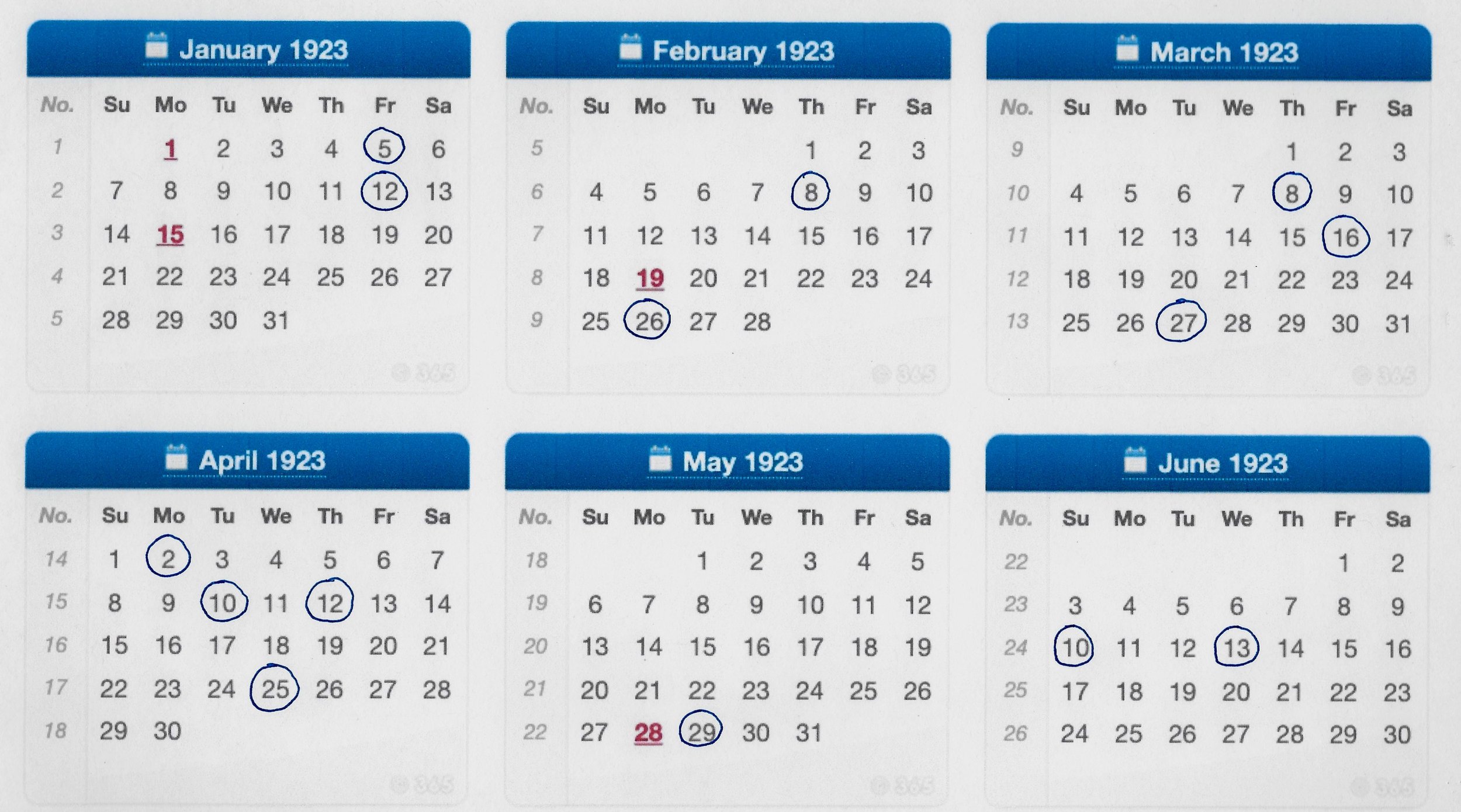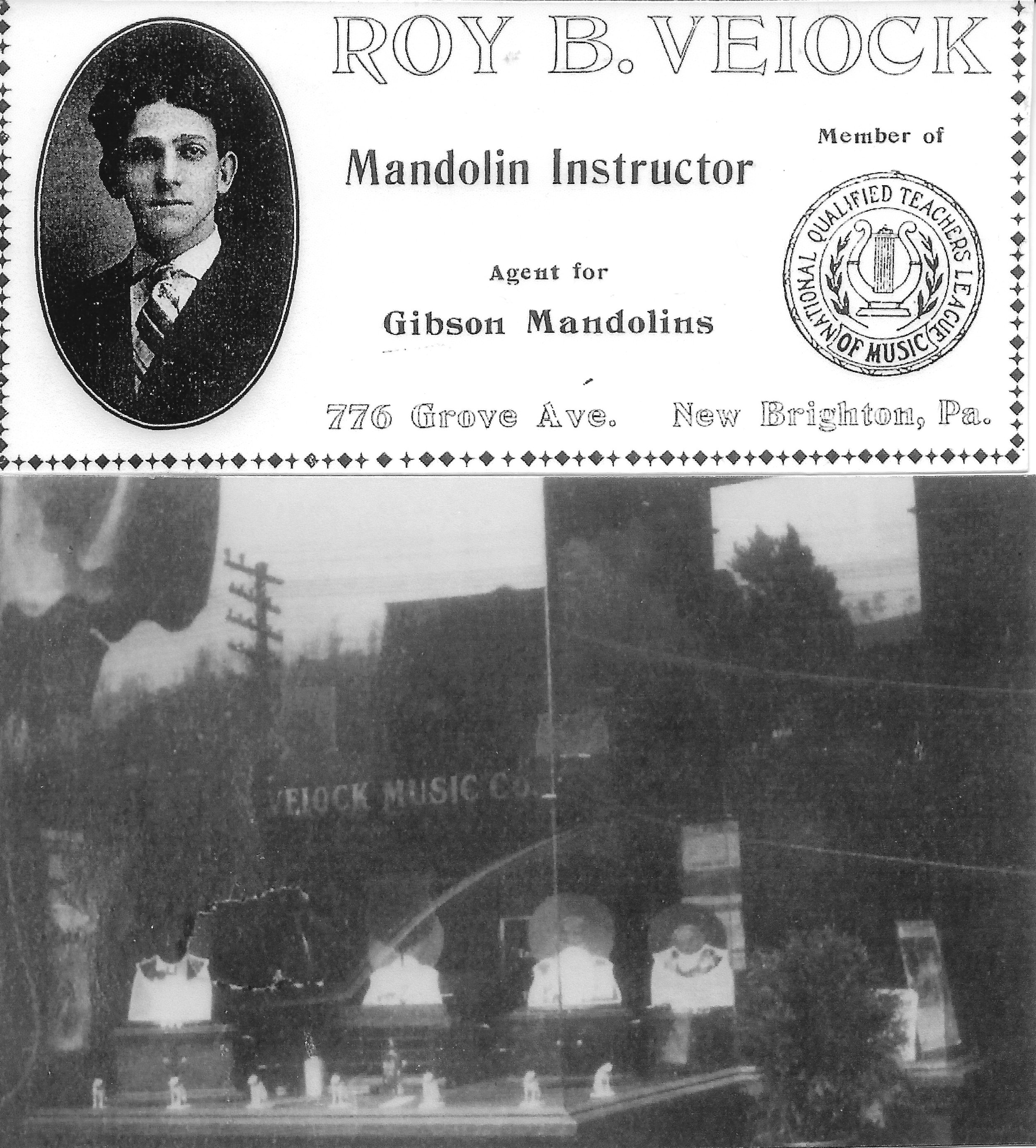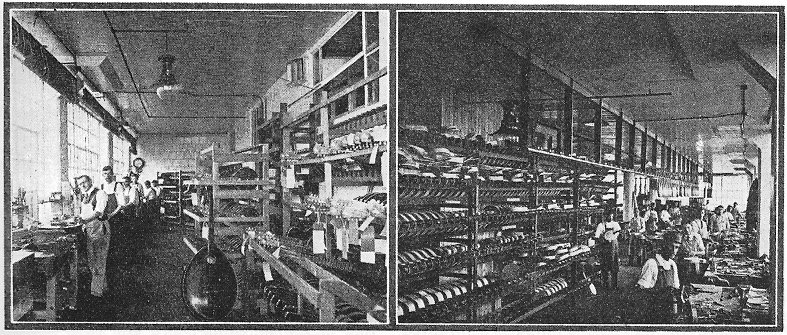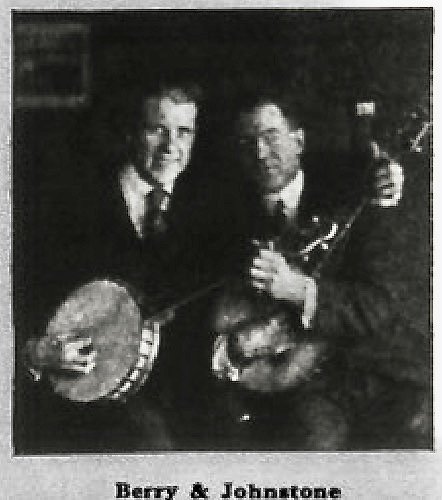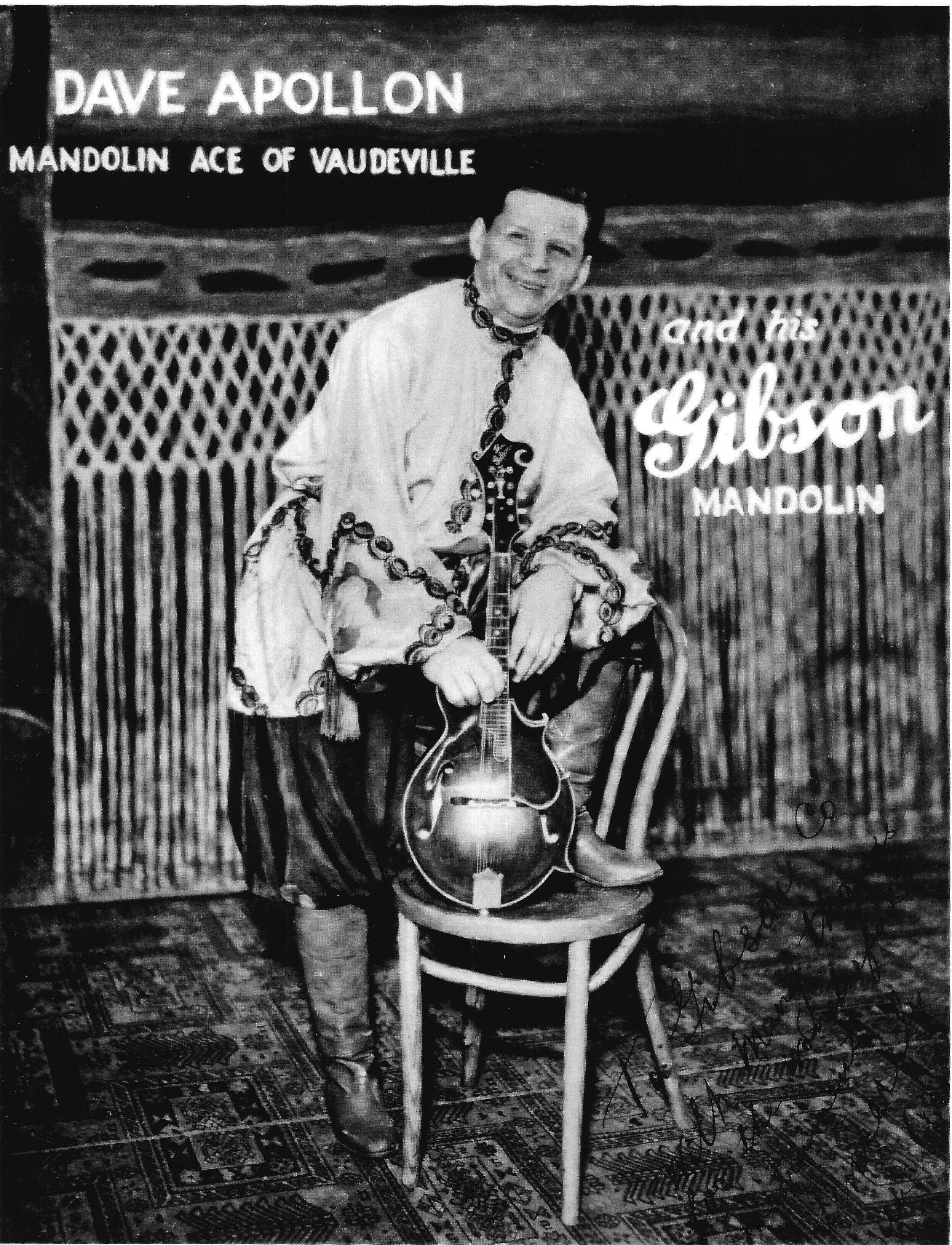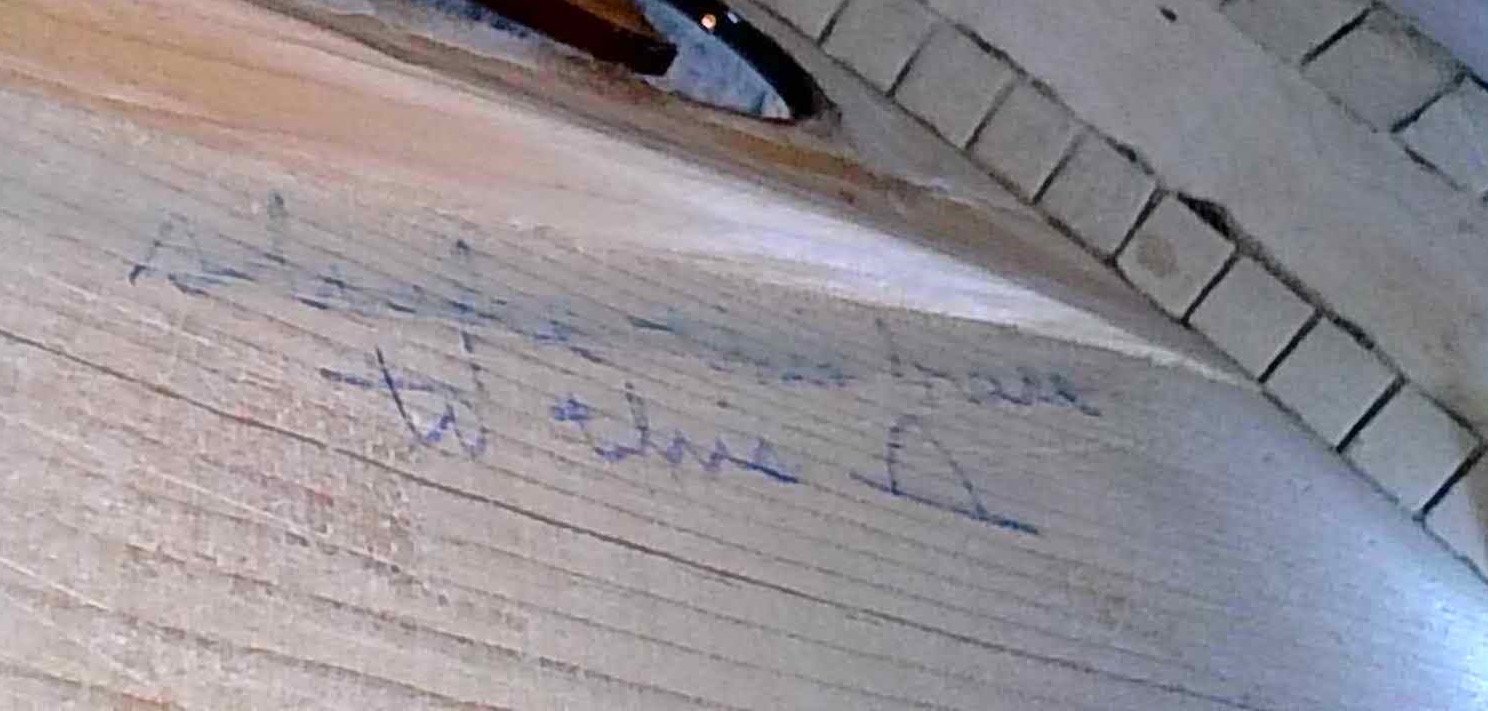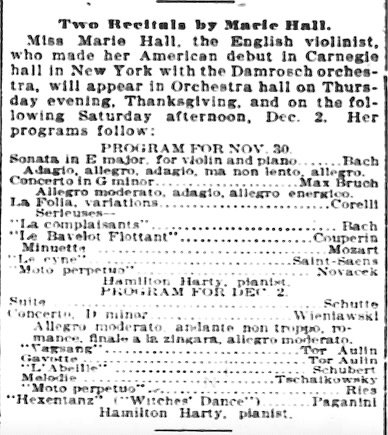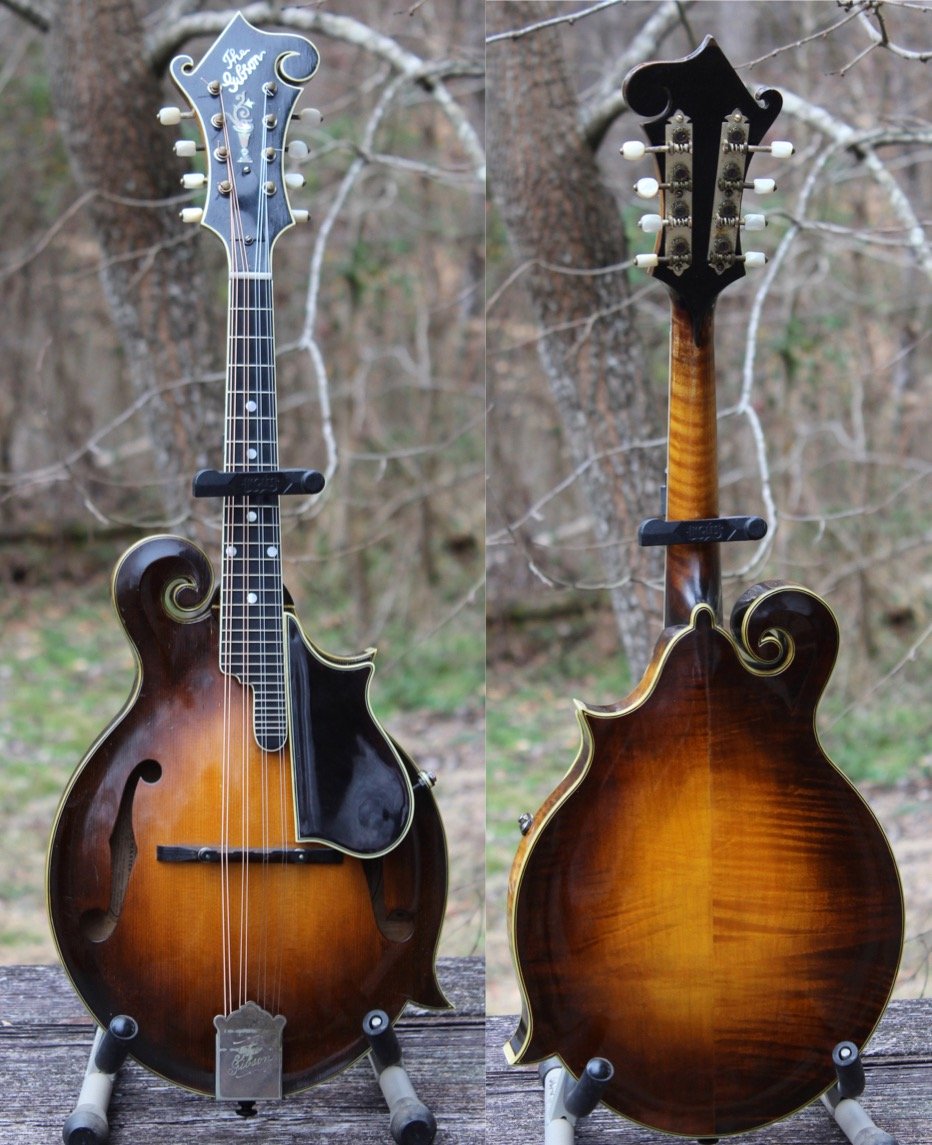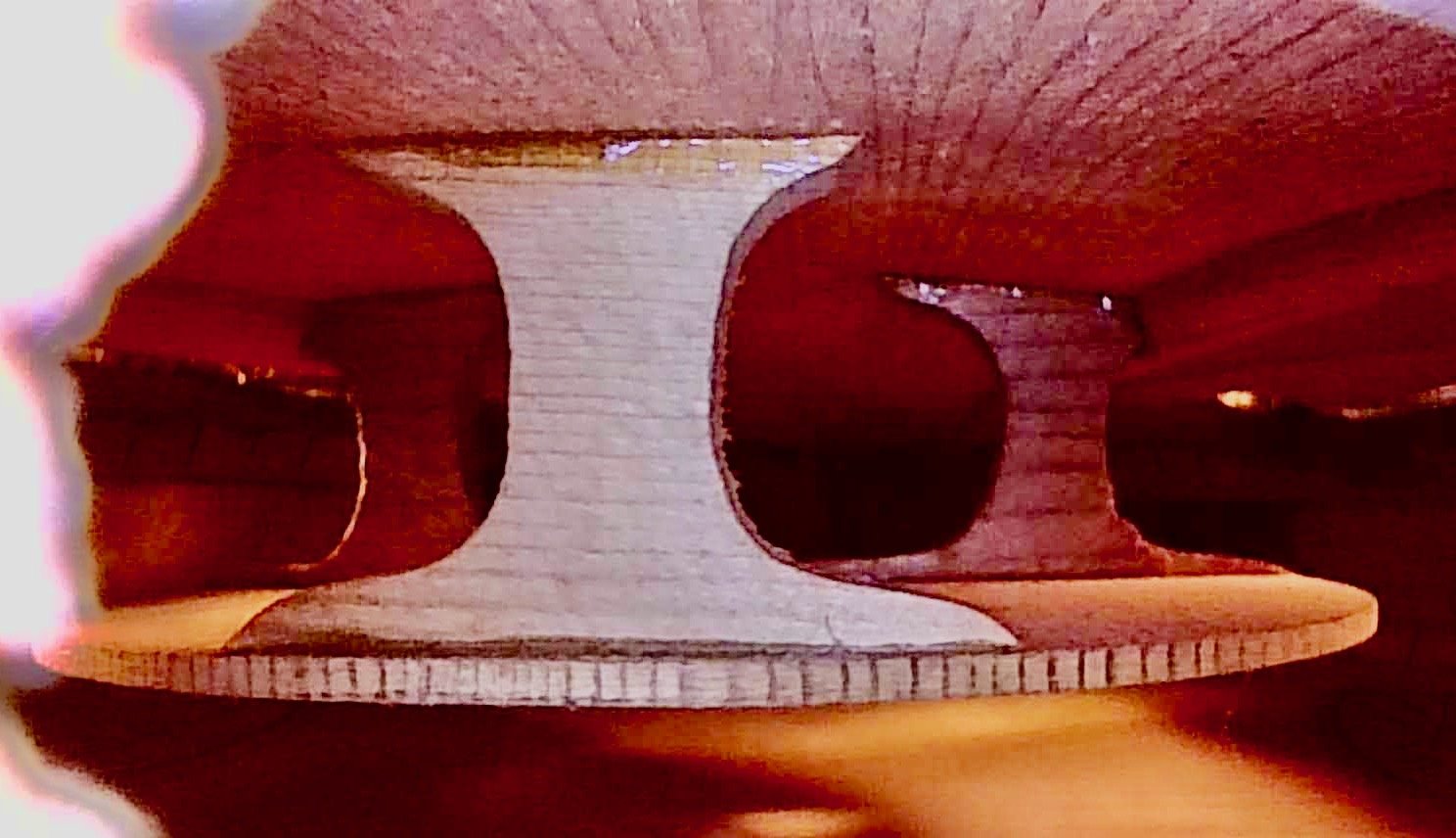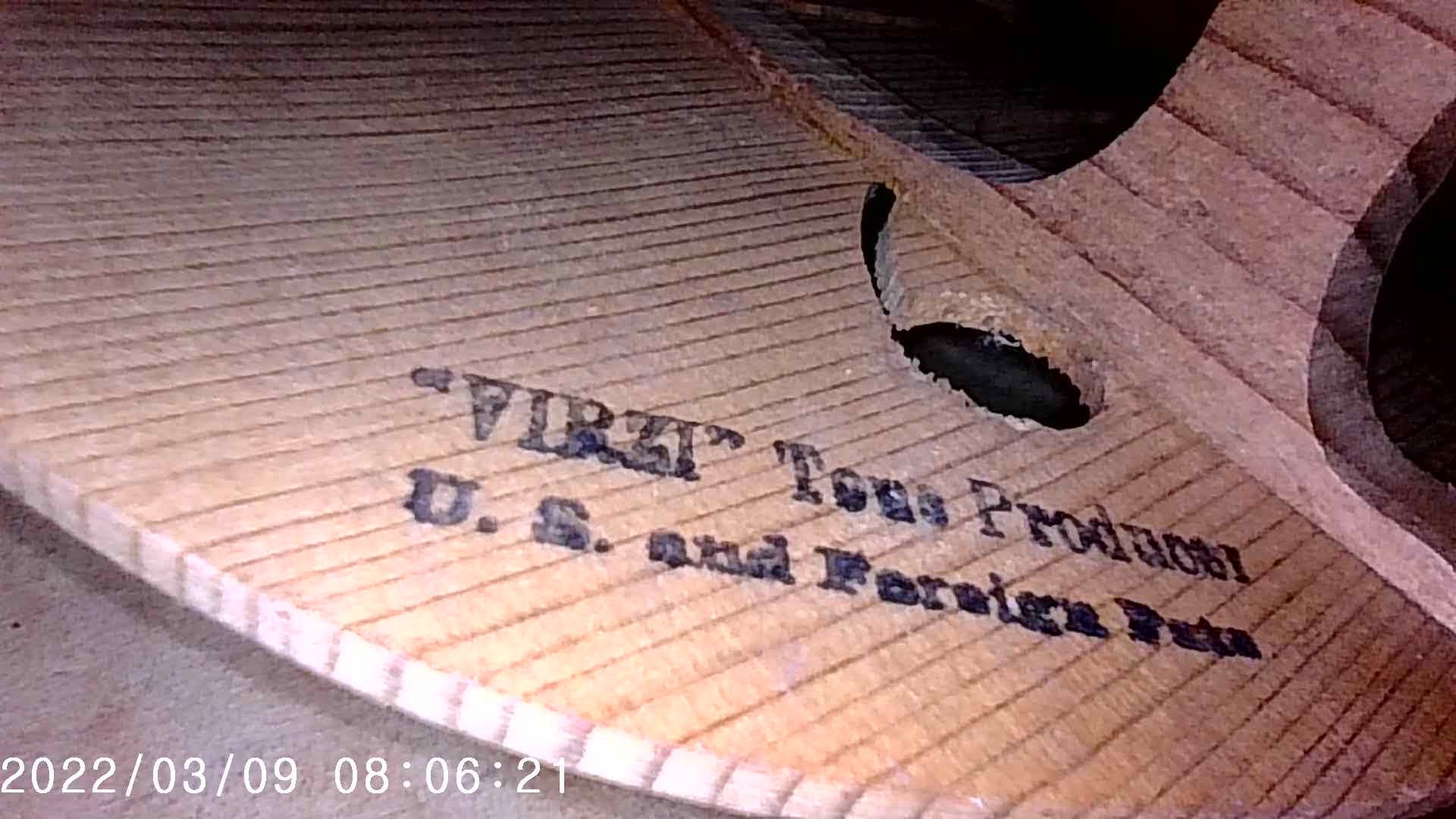Miami Herald Sun, January 7, 1945. One of two posters created for the concert at the Orange Bowl.
William Smith Monroe, 1945, shortly after acquiring Gibson F-5 73987, signed by Lloyd Loar on July 9, 1923.
One auspicious day in January of 1945, Bill Monroe found his Gibson F-5. Even before that first glimpse of 73987, he knew that the F-5 was the top of the Gibson mandolin line. He would have seen, and perhaps even played, the 1930 F-5 in the hands of Robert Gardner, of the popular blind duo “Mac and Bob,” a mainstay of the WLS National Barn Dance in Chicago. Bill and brother Charlie had moved to Chicago in the early 1930s to work for Standard Oil, but quickly found a place as dancers on the Barn Dance. By 1933 they were regular features on that program.
Lester MacFarland (guitar) and Robert Gardner (mandolin), the popular duo “Mac and Bob.”
In 1933, Monroe received several autographed photos with dedications to him from Dave Apollon (see Breaking News 1922). Apollon, of course, played Gibson F-5s for his entire career, which in 1933, included performances in motion picture, concert halls and on Vaudeville stages. “To Bill / with All best wishes / Sincerely, Dave Apollon / Sep 20-1933”
Copy of original courtesy Tom Isenhour.
Although Apollon frequently performed in Chicago, and was there on many occasions in 1933, it is somewhat unclear the exact circumstances where Monroe received this autograph. According to the Washington Daily News Dave Apollon was engaged as the master of ceremonies at Lowe’s Fox theatre in Washington, D.C. that week. This review was published on the date of the autograph, September 20, 1933, presumably for the performance of the night before. The Daily News’ music critic, Don Craig was evidently quite displeased with Mr. Apollon’s introduction of the visiting Diva. Did Mr. Apollon behave differently on the night of the 20th? (The irony is that the reviewer does not understand that Apollon, who had studied with Jascha Heifetz and danced at the Bolshoi, simply understood that entertaining an audience was his key to success). But more importantly, was Bill Monroe there that night in Washington to receive that autograph, and what circumstances would have brought him there?
The Washington Daily News (Washington, District of Columbia) · Wed, Sep 20, 1933 · Page 19
Musicians, and country musicians in particular, have always had a particular affinity for proudly displaying their guitars. Acquiring the best musical instruments became not only an ingredient of sound, but also an essential part of the artist’s identity. By the 1950s, fancy guitars, like Nudie suits, were an earmark of success and affluence. When The Carter Family and Jimmie Rogers first began receiving handsome royalty checks in the late 1920s, they bought top of the line instruments: The Gibson L-5 for Maybelle Carter and Martin 000-45 for Rogers. The Monroe Brothers were no different. By the late ‘30s, Bill had a new Gibson F-7 mandolin and Charlie the Jumbo model Gibson guitar. After the brothers went their separate ways, Charlie’s continued success earned him the wherewithal to afford a Martin D-45, the most expensive guitar of the era. Considering the well-publicized rivalry between the two brothers, we have no doubt that Bill Monroe would have been a likely candidate for an upgrade to his mandolin.
Scrolls on two F-5s dated July 9, 1923. Left: 73753 with standard binding; Right, 73994 with black stripe on the side. The mandolin in the barber shop, 73987, featured the rare side binding.
On the occasion of Mr. Monroe’s birthday, we want to review the incredible events that led to that day, that city, that barber shop and that mandolin.
Miami New, Wednesday, January 10, 1945.
In the years from 1939 through 1942, Bill Monroe and The Bluegrass Boys rocketed into the top echelon of hillbilly entertainers. Along with Roy Acuff, he was the headliner on the nationwide broadcast, The Grande Ole Opry, which blasted out of Nashville, Tennessee, with 50,000 Watts on WSM Radio each Saturday night. Played to a packed house at the 3500-seat Ryman Auditorium, these shows, which were also carried by NBC affiliates, captured the excitement and electricity of Bill Monroe’s performances and transported it to living rooms all across North America. Throughout the 1940s, Monroe ruled the airwaves with two Saturday night spots: 8pm to 8:30, sponsored by Purina, and 10pm to 10:15, sponsored by Wallite. Afterwards, and often immediately after, Monroe’s 1942 Buick Roadmaster Model 71 (purchased in 1942) and the 1941 Chevrolet Airport Limousine (purchased by 1945) led an impressive caravan of automobiles carrying musicians, comedians, instruments, a circus tent and even a baseball team (during the summer months) across the southern United States. They travelled and performed Sunday until Friday, after which they always made it back to Nashville for the Saturday night Opry. Passionate fans driven by those broadcasts poured out to hear the show when Bill Monroe came to their town. (Many thanks to Tom Isenhour for his work in identifying the automobiles of Bill Monroe).
Bill Monroe and the Bluegrass Boys, autumn 1944. Left to right: Curley Bradshaw, “Sally Ann,” Monroe, Chubby Wise, Clyde Moody and “Stringbeans.”
On May 15, 1942, a great deal changed for traveling entertainers when the US government began rationing gas and rubber for the war effort. Gas stickers were granted based on how an individual contributed to the war effort. The “A” sticker entitled a car owner to 4 gallons a week and the “B” sticker, only 3 gallons. It is unclear how Bill Monroe managed to keep automobiles that only got 8-10 miles per gallon on the road, but one suspects Mr. Monroe depended on loyal fans all over the south to share, sell or give their rations. It has been reported that they carried cans for collecting gas along the way. Tires may have been much easier, as the Chevrolet Airport limousine used the same tires as some private airplanes, most of which were grounded during those years. Those tires would have been readily available at the many small landing strips along the way. (Thanks to Red Henry for his research on the connection between Monroe and airplane tires. Mr Henry points out “those car-size tires, as large as they are, were probably found only on larger private planes and the smaller airliners of that era.”).
However he managed these obstacles, he made personal appearances in Tennessee, North Carolina, South Carolina, Georgia, Alabama and Kentucky in 1943 and 44. For reasons that had nothing to do with the war, the American Federation of Musicians called for a ban on all recording beginning on August 11, 1942, and negotiations dragged on until November 11, 1944. Columbia records had signed Monroe before the ban, but had to wait to record him. (It was on February 13, 1945, at the CBS studios in the Wriggly Building in Chicago, Illinois, that Monroe kicked off his first recording session for that company with “Rocky Road Blues”). Despite the impact of these limitations, Bill Monroe still seemed to flourish. All the way down in southern Florida, NBC affiliate WIOD in Miami carried his show live every Saturday night during those years, and the Miami News and Miami Herald both carried notices reminding people to listen for Bill Monroe. Articles promised that “Bill will be singing the Mule Skinner Blues!” Or, “you will hear favorites like ‘Arkansas Traveler,’ ‘The Girl I Love Don’t Pay Me No Mind,’ ‘Black Jack Davie’ and ‘Katy Hill.’” Just as often, they would proclaim that the Bluegrass Quartet will be singing “religious numbers like ‘I Found A Hiding Place.’”
Bill Monroe and the Bluegrass Boys, October, 1944: Standing L to R: Clyde Moody and Bill Monroe; Front row: Howard Watts, “Sally Ann,” Chubby Wise, “Stringbeans.”
Immediately after the Opry show on January 7, 1945, Bill Monroe and a huge entourage drove out of Nashville headed for south Florida, his first trip that far south. Earl Scruggs made that same journey with The Bluegrass Boys one year later. In an interview with this author in January, 2007, Scruggs recalled his first trip as a Bluegrass Boy: “When we left Nashville that night after playing the Opry, we struggled through winter weather on two lane roads, some not paved, to make it to Atlanta around daylight. In Atlanta there were 93 stoplights. By the time I left Bill, I knew every one of them by heart. The lights were timed so that if hit you the first one just as it turned green, well, then, you could cruise on through. I remember that after we had made a few of the lights on green, a hay wagon pulled out in front of us and we hit every red light from then on. When we finally made it through Atlanta, we still had to go to Miami. It’s a long way from Atlanta to Miami.”
The Bluegrass Special! L to R: Monroe, Jim Shumate, “Sringbeans,” Lester Flatt, “Sally Ann” and “Howdy” Forrester. November 28, 1945, en route to show dates in Johnson City and Morristown, Tennessee. Photo from “Purina’s Grand Ole Opry Souvenir Album” dated 1946. (Original booklet given to this author by banjo scholar Jim Mills.)
January 1945 must have been just as grueling for the Bluegrass Boys and Girl. After performing on the Opry, they left Nashville at mid-night on the 7th. The first show was at The American Legion Arena in West Palm Beach on the 9th; then, down to the “Orange Bowl” (Burdine Stadium) in Miami for two shows, the 10th and 11th. Somehow, they made it all the way back to Nashville in time for the Opry on Saturday the 13th, after which they turned around and headed back to Florida for the Central High School Auditorium in Fort Lauderdale on the 15th and Vero Beach High School Auditorium on the 19th. Back to Nashville for the Opry on the Saturday the 20th, then back to south Florida for the Grade School Auditorium in Fort Pierce on the 24th, and, yes, back to Nashville in time for the 8pm set on the Opry on the 27th. In fact, the entire year of 1945 was like that, a non-stop, superhuman journey.
Bill Monroe Performances 1945: we can confirm all these dates and personnel based on newspaper ads and first hand accounts. More than likely there were many more.
The Palm Beach Post Tuesday, January 9, 1945.
Who got on board in January of 1945? Fiddler Chubby Wise and bassist Howard Watts (“Cedric Rainwater”), were both from Florida and may have encouraged Bill to expand his range in that state. Dave “Stringbeans” Akemen (later changed to “Stringbean”), from Eastern Kentucky, was Monroe’s first banjo player and had been with him since 1942. Originally from New Mexico, Wilene “Billie” Russell Forrester, whom Bill introduced as “Sally Ann, the Kentucky Songbird,” sang and played accordion all through the war years. (Billie was the wife of champion fiddler Howard “Howdy” Forrester, who left Monroe’s band to join the Navy on March 6, 1943. He endured bitter fighting in the Pacific while serving on the USS Pennsylvania, and was finally discharged on November 21, 1945 after the ship was torpedoed off Okinawa that August. Monroe gave him his job back when he returned). Clyde Moody had been Bill’s duet partner all through the war, and had acquired a good following of his own. But when the recording ban was lifted, Moody made his own deal with Columbia Records and was scheduled to head to Chicago just a few days after the Bluegrass Boys. To fill the significant loss of Moody on guitar and lead vocal, Monroe hired Georgian Tex Willis, who had been recommended by Wise and Watts. Curly Bradshaw joined on second guitar on some numbers and did solo spots with his “mouth harp” in the style of African American harmonica master Deford Bailey. This is the band that Bill would take to Chicago for that first landmark Columbia session, and one imagines musical chemistry congealing on this tour. In addition to the Bluegrass Boys, Zeke Clements was along as well. He shared the bill with Monroe, promoting his new hit, “Smoke On The Water.” “Grand Pappy” George Wilkerson and comedians Jam-Up and Honey added their minstrel antics. Thus, Monroe was able present a full in-person “Grande Ole Opry” experience to audiences throughout the South.
Fort Lauderdale News, Jan, 13, 1945. Note the names of the stars inverted.
In all probability, it happened in Miami. The stars lined up for an immeasurable impact on both Bill Monroe and the F-5 mandolin. On January 10, they arrived at Burdine Stadium, which filled the area between 6th and 3rd Streets in Little Havana just west of the Miami River. The first task was to erect the tent and arrange the bleachers and stage. Light rain commenced that night, and the temperature went down to 43 degrees Fahrenheit. It was a chilly night for folks in Miami, but they must have been snug inside the tent listening to their favorite Opry stars live for the first time. Without doubt, Monroe treated the audience to “Muleskinner Blues” and other powerhouse numbers that had made him a household name. The band was experiencing the excitement of a new configuration with the talented Tex Willis stepping into Clyde Moody’s place. As Moody was on the Opry with Monroe as late as December 2, this was most likely one of Willis’s first tours as a Bluegrass Boy. At some point he introduced a style of rhythm guitar playing that emphasized a strong back-beat. This perfectly complemented Monroe’s fast blues compositions like “Rocky Road Blues.” (Music scholars often cite this sound as an important root of Rock ’N Roll). We have no idea where the travelers found lodging for the night, but late 1940s Bluegrass Boy Jim Eanes told this author “he never saw the inside of a luxury hotel when he was with Monroe.” At best they might have arranged an inexpensive hotel or boarding house in Little Havana, which would have seemed luxurious after surviving on cat naps in the car. The morning of the 11th, they woke to a beautiful January day with a high of 64 that afternoon. If anyone wanted to get out for a walk, that morning or early afternoon would have been the best opportunity. Monroe often mailed correspondence, and the Main Post Office was located on the east side of the river on the block at 1st and 4th Streets. To go there from the stadium area, he would have walked across the bridge at 5th street and then turn down to 4th. There were any number of grand hotels along 4th, 5th and Biscayne: The Alcazar, the Floridian, and at 258 NE 4th Street, the brand new Liberty Hotel, just past the Post Office toward Bay Front Park.
Downtown Miami, ca. 1945. Arrow on left, Burdine Stadium where the concert was held January 10 & 11. Arrow on Right, The location of the Liberty Hotel. Total walking distance from stadium to beachfront, 2 miles.
These hotels all featured barber shops with windows to the street. Of course, there were independent barber shops all through Miami in 1945 including Stricklin’s, Sunlight, Star, Stokes’, Rialto, Royal, Rossi, Sam’s, The Seabreeze, and Reagin’s. After researching all of them, we discovered a number of classified ads for high quality musical merchandise, mostly mandolins and accordions, which had been posted in the Miami Herald in 1944 and early 45. All these ads listed the same address: “258 NE 4th Street.” The Liberty Hotel! Each ad used a different name but the same address: “A Mr. M. H. Davis offered a Pietro Accordion for $300”; “Dee” offered an “Italian bass accordion, best offer”; “Fine Gibson Mandolin with a $15 case” no name , just the address; and “Mr. Smith” offered for sale a “Gibson Mandolin, $150 with a leather case.” (In aftermarket ads, the keratol cover of the Geib & Schaefer cases used by Gibson were often mistaken for leather).
Miami Herald, classified ad, 1945. We certainly cannot confirm that this was an F-5 mandolin, but it does confirm that someone was dealing in fine Gibson mandolins and using the address at the Liberty Hotel in 1945.
The Liberty Hotel facing 4th Street, Bay Front Park in the background. (Postcard dated 1945)
The night of January 11, the temperature outside went down to 38 degrees, a record low there for that year. We cannot help but think Bill Monroe heated up that tent at Burdine stadium with Gibson F-5 73987, signed by Lloyd Loar on July 9, 1923, with the black stripes on the side. (Monroe often told the story that he found his F-5 in a “barber shop in Miami”). There is no greater confirmation of the fire that mandolin lit in him than the first recording of “Rocky Road Blues” made in Chicago one month later. The temperature may have hit a record low that night in Florida, but Bill Monroe hit a record high for the century of the F-5 mandolin.
Bill Monroe with Gibson F-5 73987 on stage at the Grande Ole Opry, ca. 1946: This was the most important mandolin of his entire career, and an inseparable icon of his musical identity. (Howard Watts behind with bass)

